


























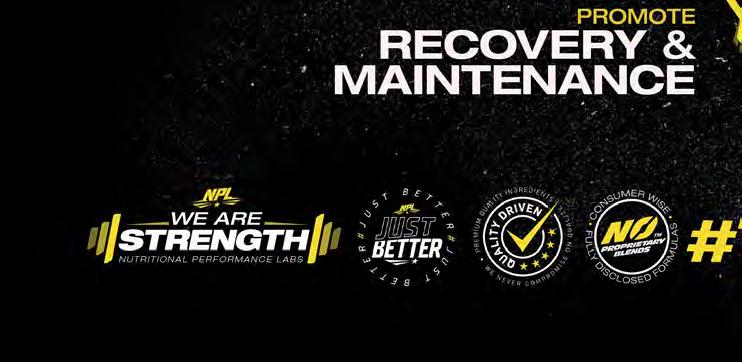
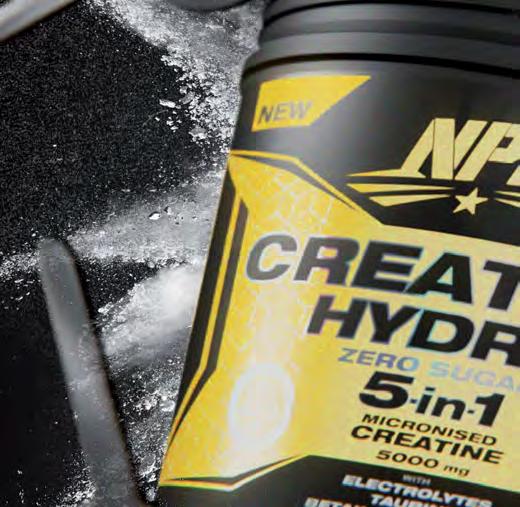













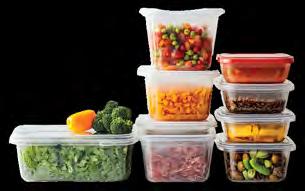



Menopause


































































Menopause



















The strongest, most impressive structures are built from a solid foundation. Without this stable platform to build on, even the most carefully constructed structure becomes vulnerable.
The same is true for your body and immune system, especially during winter, when our immune defences are tested by cold weather and circulating cold and flu bugs.
Just like concrete is the foundation of towering buildings, nutrition is the base on which your immune system stands.

Your immune system can’t fight off colds, flu and other seasonal invaders effectively without the right tools – the vitamins, minerals and macronutrients that play a role in supporting our immune defence.
Without them, our body’s protective walls develop cracks and gaps that make it easier for illness to break through.
When it comes to boosting your immune system, it’s the daily choices we make that matter most – the bowl of vegetable soup, the morning smoothie with spinach and berries, proper hydration and giving your body added nutritional support where needed.
That’s why you should make Dis-Chem your hub for winter wellness this season. We stock a wide range of nutrient-packed healthy foods, superfood ingredients and the biggest range of health and
immunity supplements.
We continue to grow our offering, adding new brands and products to our shelves to give you greater choice and more tools to build the solid foundation needed for winter wellness.
Our commitment to quality is unwavering, selecting only the best, most trusted local and international brands, with all the insights and information you need to get the most for your investment in healthy living.
A look at the product news pages in this issue will demonstrate the depth of our offering, with the articles and information shared in the pages that follow your guide to navigating winter with abundant energy, resolute focus and a determination to succeed that cuts through the cold.
Let’s weather the cold together!

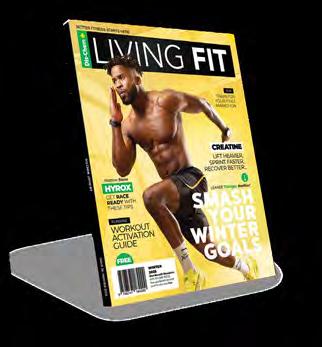

Immunity is the name of winter wellness game. Whether you’re aiming to train through the cold to maintain your momentum or achieve your performance and physique goals come summer, or simply sail through the cold and flu season unscathed, this issue is packed with expert immune-boosting tips and insights.
Discover the natural immune boosters you can add to your shopping list for added support this winter on page 50, and what exercises and intensity is best to support, not overwhelm, your immune system (pg 106).
We also look at how nutrition and supplements can help you build immunocompetence – your immune system’s ability to resist and control infections (pg 58).
We’re not taking our foot off the gas in this issue just because the winter chill has set in. Read on for tips and inspiration to achieve peak performance this winter.
Whether you’re about to hit the weights (pg 86) or a run (pg 120), we’ve got the perfect pre-workout activation plans to warm up cold muscles and reduce injury risk.
You can also take your running to the next level with our comprehensive marathon training plan. Visit page 110 for a guide on how to make the transition from 21.1km to 42.2km and conquer what many runners believe is the ultimate test of endurance.
Creatine – arguably the most effective performance-enhancing supplement on the market –takes centre stage in this issue, with the perfect timing and dosing strategy (pg 98) and the benefits for women, especially those in menopause (pg 66).
Our experts also reveal how women can work with – not against – their cycle to perform at their best (pg 62).
We’ve also got our regular dose of inspiration with profiles on top South African athletes making their mark on the international stage.
Pro HYROX athlete and hybrid training coach Matt Stone shares his top training and competition tips on page 90 as HYROX fever grips the country.
For those looking for some winter weight-loss motivation, read about Danélle Breedt’s inspirational transformation in the 12-week NPL Body Rev Challenge and the life-changing benefits her success has delivered (pg 78).
Warm winter wishes from the Living Fit team

Living Fit Magazine is published on behalf of by (Pty) Ltd

Publisher: Tanja Schmitz tanja@livingfit.co.za
Managing Editor: Pedro van Gaalen pedro@livingfit.co.za
Creative Director:
Sean MacTavish
Video:
Luigi Lombaard, Kayleigh Mocke, Gareth D’Enis-Rowson
Design & Photo:
Shelby Imrie, Ernst Robbertse
Advertising: sales@livingfit.co.za
Copy Editing: Lauren de Beer
Online Media & Editorial:
Gary Fairweather, Logan MacTavish, Laura Smith, Shannon Davies and Siovahn Bezuidenhout
CUSTOMER CARE:
Care-line: 0860 347 243
Telephone: 010 589 2200
Mondays to Fridays: 08:00 to 16:30
Price and product disclaimer
All products, prices and special offers displayed or advertised in this magazine were correct at the time of print. Pricing and product availability in-store or online are subject to change without prior notice. While every effort is made to ensure accuracy and relevance in this regard, Dis-Chem and Io Media accept no responsibility for pricing changes, discrepancies and typographical errors, and cannot be held liable for any potential loss, damage or expense incurred as a consequence. In instances of errors, Dis-Chem reserves the right to cancel offers advertised at the incorrect price. Additional restrictions may apply.
Content disclaimer
Dis-Chem Pharmacies (Pty) Ltd and Io Media (Pty) Ltd cannot guarantee the accuracy of the content in this publication, which is provided for general information purposes only – no part of it constitutes medical advice. No liability is assumed by Dis-Chem, Io Media, Living Fit or its contributors for the information provided in the magazine and actual product performance and efficacy may vary based on many factors. Readers are advised to discuss any exercise, dietary, supplement or nutraceutical interventions with a suitably qualified medical, exercise or nutrition expert for individualised advice. Dis-Chem and Io Media accept no responsibility for any direct or indirect loss, damage or injury readers may suffer as a result of using or relying on any information contained in this magazine. All rights reserved.




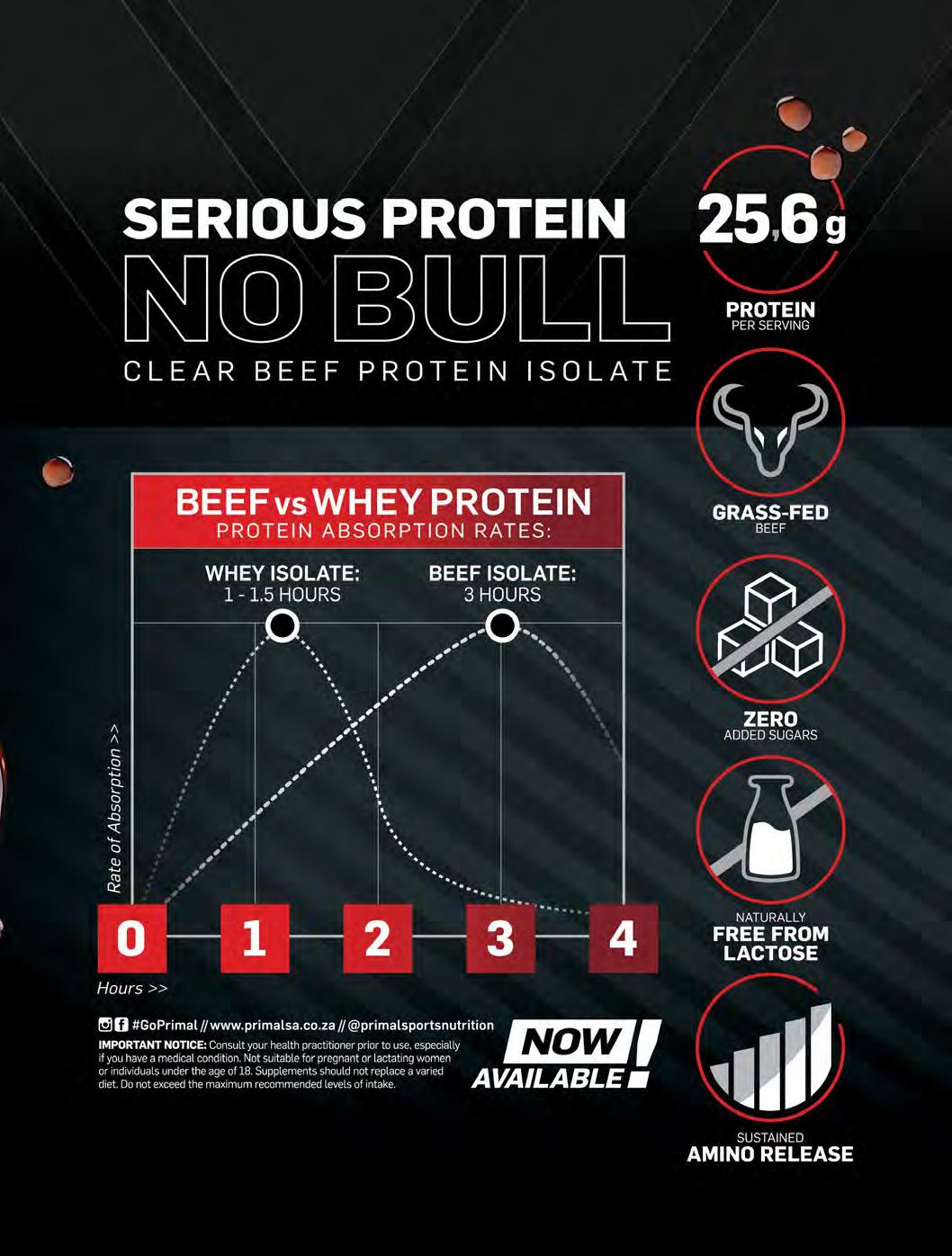




Absa Rewards members who are also members of the Dis-Chem and Dis-Chem Baby City Benefit programme will be eligible to earn up to 30% cash back on all qualifying spend depending on your Absa Rewards tier.
Everyone can live better with cash back at Dis-Chem and Dis-Chem Baby City. Simply pay with your Capitec debit or credit card and get 1% cash back on qualifying items in-store. The cash back will be transferred into your Live Better savings account monthly, where it will earn even higher interest!
If you’re a Discovery Bank client and Vitality Health member, you can get up to 50% back on thousands of HealthyCare and HealthyBaby items at both Dis-Chem and Dis-Chem Baby City stores. Vitality HealthyCare and HealthyBaby rewards you for taking care of yourself and your family, making preventative and everyday personal and family care easier and more affordable. (You’ll earn these rewards in Discovery Miles, Discovery’s rewards currency with more ways to earn and spend them than ever before.)
Multiply members get up to 12% in cashbacks, depending on their qualifying tier, paid into their Momentum Multiply savings account, when shopping at Dis-Chem or Dis-Chem Baby City.
Planet Fitness members who swipe their Dis-Chem Benefit Card when purchasing any Biogen, USN, Evox or Muscle Junkie products in-store or online will earn an additional 10% back in Benefit Rewards.
Filling up at a TotalEnergies service station just got more rewarding! Simply swipe your Dis-Chem or Dis-Chem Baby City Benefit Card when you’re paying for your fuel, and you’ll earn Benefit Rewards. For every litre of fuel you will be awarded 10 Benefit Rewards. Only fuel purchases will earn you Benefit Rewards.

Earn up to 20%* back in UCount Rewards Points on all qualifying spend at Dis-Chem. Earn up to 5% back in Ucount Rewards points at Dis-Chem Baby City. Terms and Conditions apply.
*Valid in South Africa only





Shop our wide range of products, from health and beauty essentials to personal care items, supplements, and much more, all available at the click of a button. Best of all, Dis-Chem online offers a variety of secure payment options to choose from. Shop with peace of mind, knowing that your transactions are protected, ensuring a safe and seamless shopping experience.
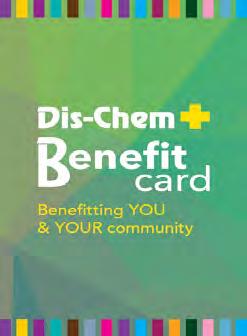
Experience the ultimate convenience of shopping from the comfort of your home with Dis-Chem’s Click & Collect service. Say goodbye to queues and enjoy a wide variety of products at your fingertips. It’s as easy as a few clicks! With Click & Collect, available in all Dis-Chem stores, you can conveniently pay for your items online and collect them in-store. Best of all, there’s no additional cost for this service. Orders will be ready for collection within 24 hours. Once your order is ready for collection, we’ll notify you via email and SMS. Our Click & Collect service is available seven days a week, allowing you to shop at your convenience. While you can include over-the-counter medications in your online shopping, please note that prescription medications are not eligible for this service. Enjoy the ease and flexibility of Dis-Chem’s Click & Collect service, which brings you a seamless shopping experience without leaving your home. Visit our website, www.dischem.co.za, for more information.
Your go to health store is right at your fingertips
Experience the convenience of Dis-Chem DeliverD, your go-to destination for a wide range of products, from health and beauty essentials to personal care items, supplements, and much more, at in-store prices. Get all your essentials delivered straight to your door in 60 minutes, 7 days a week. Enjoy the convenience of shopping from the comfort of your home while earning Benefit Rewards with every purchase. What’s new: You can now purchase over-the-counter medication and pay with your medical aid by selecting “claim from medical aid” at checkout. T’s & C’s apply. Download our app to enjoy our convenient 60-minute delivery service.
Because loyalty should be rewarded! Benefit even more from becoming a Benefit Programme Member. Select an interest group and receive benefits and information to suit your specific needs and lifestyle. You can earn Benefit rewards on qualifying purchases every time you swipe your card in-store at the till, or by simply shopping online. Join the Benefit Programme through WhatsApp, add 0860 347 243 to your contacts and say “Hi” or, register online, in-store, via the app or by dialing *120*1085#. By shopping at Dis-Chem Pharmacies or Dis-Chem Baby City and swiping your Benefit Card, not only do we reward you, but a percentage of all eligible purchases will be donated to the Dis-Chem Foundation to assist worthy causes.
For Youth programme
Are you between the age of 18 and 25 years?
Join Dis-Chem’s YOUth programme today to receive discounts tailored for you and earn double rewards every Monday. Collect your benefit card in-store today to activate these benefits. #Made4You #DoubleitupMondays
Dis‑Chem Partners
Accelerate your rewards with our host of banking, medical aid and pure loyalty partners. Visit www.dischem. co.za or in-store at the Customer Service desk for more information.
Dis-Chem Online offers delivery from Monday to Friday, between 08:00 and 17:00. Enjoy the flexibility of choosing our affordable delivery option, with a flat rate of R35 per order or free of charge for orders over R600 in main metropolitan areas and a R150 flat fee for non-metropolitan areas. Your order will be delivered within three to five working days from the time of payment. We value your satisfaction, and if for any reason you are dissatisfied with a purchase from our online store, you can easily return it to any Dis-Chem store for a full refund, replacement, or exchange. Terms and conditions apply.


14-16 June 2025
19-20 July 2025
HYROX, the globally renowned fitness race, is heading back to Cape Town to deliver another high-energy, recordbreaking event that draws athletes and spectators from across South Africa and beyond. HYROX is an adrenaline-fuelled event that combines functional fitness and endurance as participants run 1km, followed by one functional workout station, repeated eight times. Participants can compete solo in the HYROX Open or Pro category, share the load with a partner in the HYROX Doubles or Doubles Pro division, or grab three friends and take on the HYROX Relay. The race is happening at the Cape Town International Convention Centre (CTICC). hyroxsa.com/event/hyrox-cape-town/
Durban WODWars is the number one ProAm competitive fitness competition. It is a teambased competition open to any and all fitness training facilities. There are no scaled options and there are no divisions. Athletes all compete together against one another to find the best Pro-Am team on the continent. The event format includes three days of short sprint-based competitive fitness races that push athletes to their limits. If you want a crack at the title, grab your team of four and register. wodwars.co.za
28 June 2025
Deadly Dozen events feature track and gym-based challenges designed to test physical endurance and strength. Deadly Run, the main event, combines 12x 400m track runs with 12 Labours (exercise stations). Gym races include Deadly Strong, focusing solely on the 12 Labours, and variations like Deadly ERG races, which integrate rowing, skiing or biking between Labours. From high-intensity intervals to mixed-modality endurance, these events offer participants diverse, rigorous challenges to push their limits in unique fitness competitions. The next event takes place at the University of Johannesburg Athletics Track. deadlydozen.com
25-26 July 2025
Entering its 11th year, the Dis-Chem Living Fit Battle is primed to deliver an unparalleled functional fitness experience at the University of Pretoria’s LC de Villiers Sports Grounds. The 2025 event promises a spectacle of strength, agility and determination that will inspire athletes and spectators alike. Battles will rage Friday evening and throughout Saturday. Witness epic big lifts and soul searching fitness challenges under the lights. thebattle.co.za
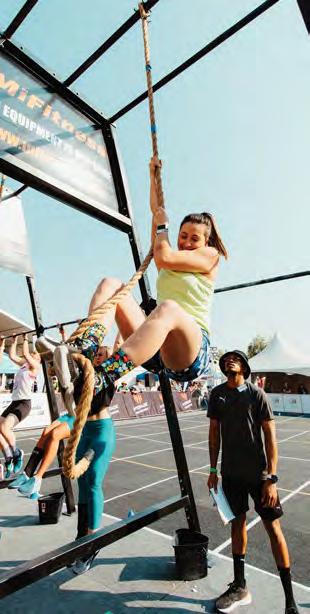

The Vitality Run Series brings Joburg runners five races across the city. Vitality members can earn 300 Vitality points for completing a 5km fun run, 500 points for running 10km and 1,500 points for completing a half marathon. With an additional 500 extra points awarded for competing in the race series, members can earn a maximum of 2,000 Vitality points. The race series includes:
Event 1: Race against Cancer
Date: 21 June 2025
Event 2: Rockies Gerald Fox Memorial Run
Date: 13 July 2025
Event 3: Randburg Harriers Challenge
Date: 27 July 2025
Event 4: Old Eds Road Race
Date: 10 August 2025
Event 5: Wanderers Road Race
Date: 24 August 2025
discovery.co.za

1-3 August 2025

The Tsitsikamma – with its deep gorges, fertile plains and wild coastline – is undoubtedly one of the country’s most spectacular destinations to visit and ride a bike.
Starting at the quaint Storms River Village, the event is firmly familyfocused, providing fun on and off the bike for riders of all ages. Rather than a race, it is considered by entrants as a ride or a tour. A relaxed three days on the bike are punctuated by lingering stops at the Biogen-powered water points, with Beer and Barrel Belgian craft beers offered at the final water point of each stage.
www.stormsrivertraverse.co.za
2-3 August 2025
This exciting premium functional fitness event will comprise teams of three (male/male/female). Teams can compete in four divisions, including Scaled, Intermediate, Masters and Rx. There will be five workouts over the weekend. The leaderboard is determined purely by the standings of the teams after the five workouts. The workouts will test the athletes’ ability to strategise for the best team performance while having a ton of fun. The DJ and MCs will keep the crowd entertained and up to date with all the action all weekend.
scoreit.co.za/scoreitevents

3, 9, 17 August 2025
The Totalsports Women’s Race continues to empower women through running, uniting thousands in a shared celebration of strength, resilience and camaraderie. The 2025 edition will feature three races in three major cities, over three consecutive weeks. The journey begins in Durban on Sunday, 3 August, continues in Cape Town on Saturday, 9 August and concludes in Johannesburg on Sunday, 17 August 2025. Organisers expect to see more than 30,000 runners proudly wearing their pink event t-shirts as they take to the streets of their city in support of PinkDrive, a nonprofit company dedicated to increasing breast cancer awareness, providing education and offering free services to medically uninsured individuals across South Africa.
totalsportswomensrace.co.za


Add some variety to your daily routine by skipping the chalky tablets and bland pills for your morning fix. Rather get your vitamin boost from new Primal-C, a refreshing uncarbonated, sugarfree drink that contains 1,000mg of vitamin C, along with vitamin D, vitamin B6 and magnesium to support immune function and energy levels. Available in a tangy Orange and Red Berry flavour.
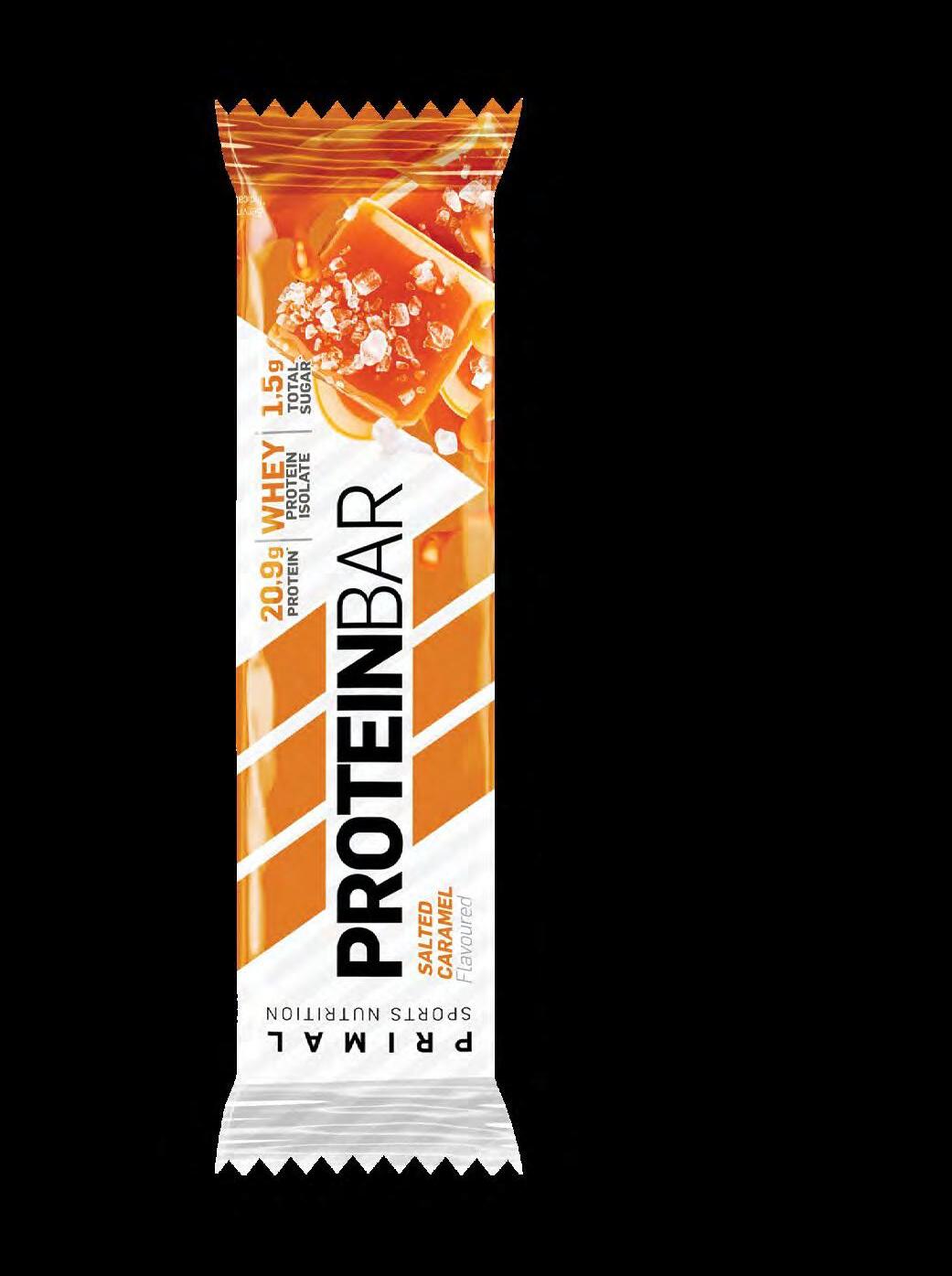

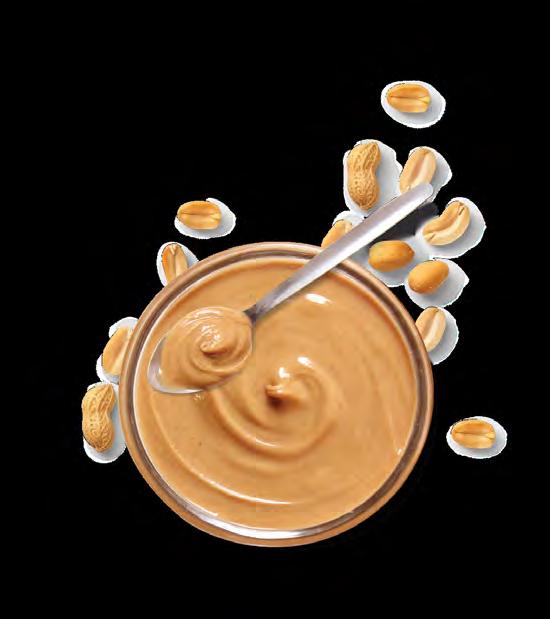

With 20.9g of protein and just 1.5g of sugar, the new Primal Protein Bar is the ideal on-the-go or post-workout snack. Made with a protein blend that includes whey isolate, this protein bar is a tasty powerhouse that fits neatly into your gym bag, lunch container or pocket. Available soon in delectable Salted Caramel and Chocolate Cream Biscuit flavours.
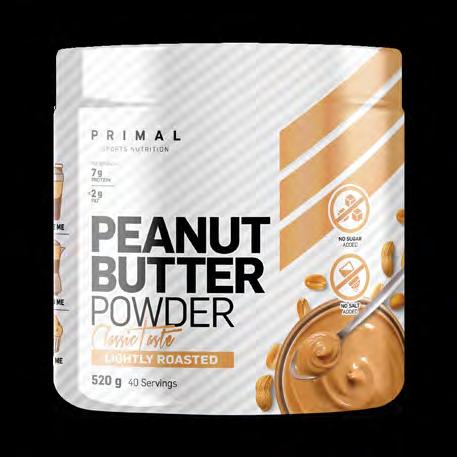
Get more servings from the new bigger 520g Primal Peanut Butter Powder tub. That means more to add to shakes, baking recipes or smoothies for some extra protein – 7g per serving – and that comforting taste of peanut butter, without all the calories and fat.


REVIVE is the perfect hydration formula for health-conscious individuals. It contains no sugar, no carbs and no calories. With 1,000mg of sodium, 200mg of potassium and 100mg of magnesium per serving, REVIVE is scientifically formulated to provide all the body needs, without colouring, additives (including anti-caking agents) or artificial sweeteners. Unprocessed and rich in natural trace minerals, the salt in REVIVE is sourced from the ancient Kalahari Desert through a special partnership with Oryx Desert Salt. Available in Dis-Chem soon, in 7 delicious flavours: Apple, Blackcurrant, Blood Orange, Raspberry, Lemon Lime, Peach and Watermelon, and the completely pure, unflavoured and unsweetened REVIVE RAW.
















Biogen Creatine + Collagen is an innovative new product that will help to increase strength, power and lean body mass with 5g creatine while supporting joint health with type-1 hydrolysed collagen. The unflavoured powder is ideal to include in smoothies or postworkout recovery shakes.

Biogen Creatine All-in-1 is a new advanced performance blend formulated to stimulate overall power and performance with 5,000mg of creatine monohydrate per serving. Added glycine (1,000mg) and L-glutamine (1,000mg) aid in muscle protein synthesis, while 1,000mg of taurine may boost energy metabolism. The overall result is more strength and better body composition when used in conjunction with a resistance training plan.
Available in refreshing Orange Tang and Berry Burst flavours


or dairy-free lifestyle can now access Biogen Plant Based Protein in a portable sachet to support on-the-go recovery and convenience. Biogen Plant Based Protein sachets offer the same formulation, which contains a plant protein blend and is naturally free from gluten, soy and lactose, making it easily digestible, especially with the added bamboo fibre.

Recharge body and mind with Biogen Supreme B-Complex. Now available in striking new packaging, this product in the Biogen Platinum range is formulated to deliver energy and stress support, with a range of B vitamins and 500mg Panax Ginseng per capsule to enhance brain function and physical capacity. Choline, inositol and folate support energy production, normal methylation and homocysteine metabolism while providing cardiovascular and nervous system





Biogen has rebranded its Travel Biotic product, now available as Biogen Supreme Probiotic 9 Strain Acute. Delivering 10 billion colony forming units (CFUs) per dose, this is the ideal product to support the rapid restoration of your gut’s microbial balance. Available in a10 pack from Dis-Chem and online at www.biogen.co.za.


Biogen is taking endurance performance to the next level with the launch of the Biogen Elite range. The Elite Carb Drink and Elite Gels leverage the latest researchbacked advances in carbohydrate formulations, combining maltodextrin and
fructose in the optimal 1:08 ratio to boost absorption and deliver more usable energy with less risk of digestive distress. The range also includes Biogen Elite Active Hydrate to support the hydration needs of top-performing athletes.



USN and Plato brew up something special


USN and coffee brand Plato have embarked on an exciting collaboration with a shared goal: to reignite the spirit of community and a renewed focus on health. Just as Plato believes in “Coffee sculpted. Community included”, this collaboration underscores a commitment to fostering wellbeing and bringing people together through movement and accessible nutrition. The collaboration includes products that can help fill the gaps in our busy lifestyles with convenient and effective sports nutrition, like Plato 100% BlueLab Whey and Plato Vooma 100 Energy Fuel Gel.
USN Super-Immune Hydrator is an instant hydration immune booster drink with vitamin C and D, and zinc. This refreshing drink helps maintain immune function and assists with hydration and recovery. USN Super-Immune Hydrator is available in three delicious flavours - Mixed Berries, Pineapple Lime and Guava Mango.


USN Plato BlueLab 100% Whey Protein
Fuel your body with 21.5g of high-quality protein per serving with Plato BlueLab 100% Whey Protein. This smooth whey blend supports lean muscle growth, recovery and performance. USN Plato BlueLab 100% Whey Protein is available in two delicious flavours – Caribbean Mocha and Coffee Freezo. Available in 704g tubs or 32 x 15g sachets.

USN Plato Vooma 100 Energy Fuel Gel is a high-performance endurance gel designed to provide rapid energy during training and endurance events. Each sachet delivers 25g of fastabsorbing glycaemic carbohydrates and 50mg of caffeine anhydrous to enhance alertness, stamina and performance These gels are available in delicious Caribbean Mocha and Coffee flavours.








NPL Lean Creatine with BCAAs and Electrolytes is a new sugarfree creatine-delivery formula that combines electrolytes and BCAAs to boost performance, recovery and support lean muscle maintenance Each serving delivers 3,000mg creatine monohydrate, 2,000mg BCAAs in the optimal 2:1:1 ratio to support muscle growth, and a unique blend of electrolytes from Himalayan pink salt and coconut water powder to improve hydration and recovery.
NPL Pro Lifestyle Dessert Pro
NPL Dessert Pro is a delicious, low-calorie, high-protein dessert with 10g of protein per serving, perfect for curbing cravings any time of day with a snack that promotes lean muscle maintenance and supports recovery.





The latest addition to the NPL Elite Pro Series is Creatine Hydra, a 5-in-1, sugar-free creatine blend with electrolytes and key ingredients known to support strength, recovery, and focus Each serving contains creatine monohydrate to maintain muscle ATP, promote strength, endurance and lean muscle maintenance.
Added taurine, betaine anhydrous and L-tyrosine further accelerate performance.
Fuel your endurance with Hydrade’s elite range of performance-focused hydration and energy solutions — engineered for runners, cyclists, triathletes and high-performance athletes. Whether you need sustained energy, rapid hydration or muscle support, Hydrade delivers clean, stimulant-free formulations to keep you going stronger for longer.



Hydrade Race Fuel is a premium, stimulant-free endurance sports drink designed to support long-distance runners, cyclists, triathletes and other endurance athletes. Race Fuel contains a multi-stage carb blend to deliver sustained energy, maintain glycogen stores and aid performance during endurance events or training sessions. Additional ingredients boost performance, aid recovery and reduce fatigue to support peak physical performance in high-intensity events or endurance challenges.



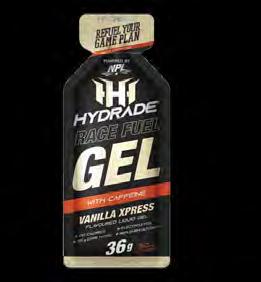


Hydrade Rapid Isotonic Energy is a stimulantfree sports drink formulated to help keep you energised and hydrated during endurance activities.
With 20g of fast-absorbing carbohydrates, it delivers a quick supply of energy to support sustained performance for runners, cyclists, triathletes and fitness enthusiasts. Added electrolytes support optimal fluid balance, replacing what’s lost in sweat, and maintain muscle function

Hydrade Race Fuel Gel is a convenient energy gel designed to sustain performance during endurance activities like marathons, triathlons or cycling events. Each sachet provides 100 calories and 25g of carbohydrates from a four-carb blend, delivering both rapid and sustained energy to help maintain glycogen levels. Added electrolytes support hydration and muscle function by replacing key minerals lost in sweat. Available in stimulant and stim-free options.
Hydrade Cramp Aid has been formulated with essential electrolytes to help replenish vital minerals lost during training and endurance events, and may support hydration and promote endurance. This blend of minerals, along with vitamin B12, may assist in reducing muscle fatigue and stiffness, and may play a role in nutrient metabolism.
Hydrade Hydrolytes is a refreshing, sugar-free electrolyte drink with essential minerals and coconut water powder to boost hydration for endurance performance and recovery support. Consume Hydrade Hydrolytes at any time of day to revitalise the body, promote hydration and increase energy levels.


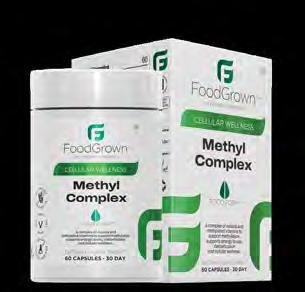
This complex of food-based and methylated vitamins, natural B vitamins, zinc, N-AcetylL-Cysteine (NAC), betaine HCl and choline supports methylation and homocysteine metabolism, which may boost energy levels, aid detoxification and improve cellular wellness.
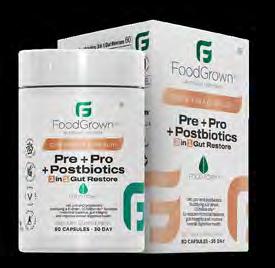
This multifaceted gut health complex was developed to aid digestion, immune health, dental health, restore the microbiome and strengthen the gut lining with pre-, pro- and postbiotics. The formulation includes a 5-strain probiotic supplying 10 billion CFUs per dose, with Orafti® Prebiotic fibre to support the growth of good gut bacteria.
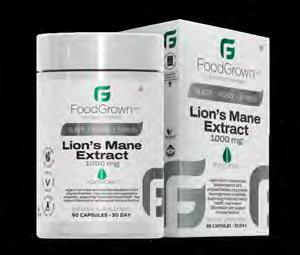
Lion’s Mane mushrooms have been lauded in traditional Chinese medicine for its neuro-regenerative properties and mood and mental health benefits. The organic Lion’s Mane extract contained in this product is standardised to 40% polysaccharides, which are the functional components of the plant and contribute to the potential health benefits. These include increased immune response and a stronger stomach lining.

FoodGrown Immune Complex is a daily complex of herbal extracts, antioxidants, vitamins and minerals with high bioavailability. Formulated to support vitality, immune function and overall good health, this product may combat inflammation, promote overall wellness and shield against colds, flu and microorganisms.
This full spectrum multi-vitamin and mineral complex contains 16 vital vitamins and minerals the body needs to function effectively. Formulated as a daily supplement to boost immune function, increase energy metabolism and support nervous system functioning and bone and tooth health.
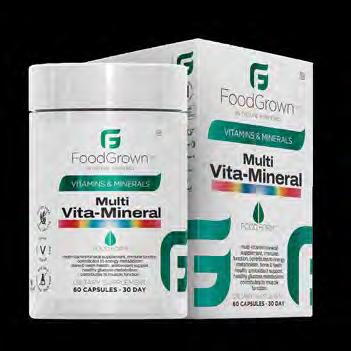
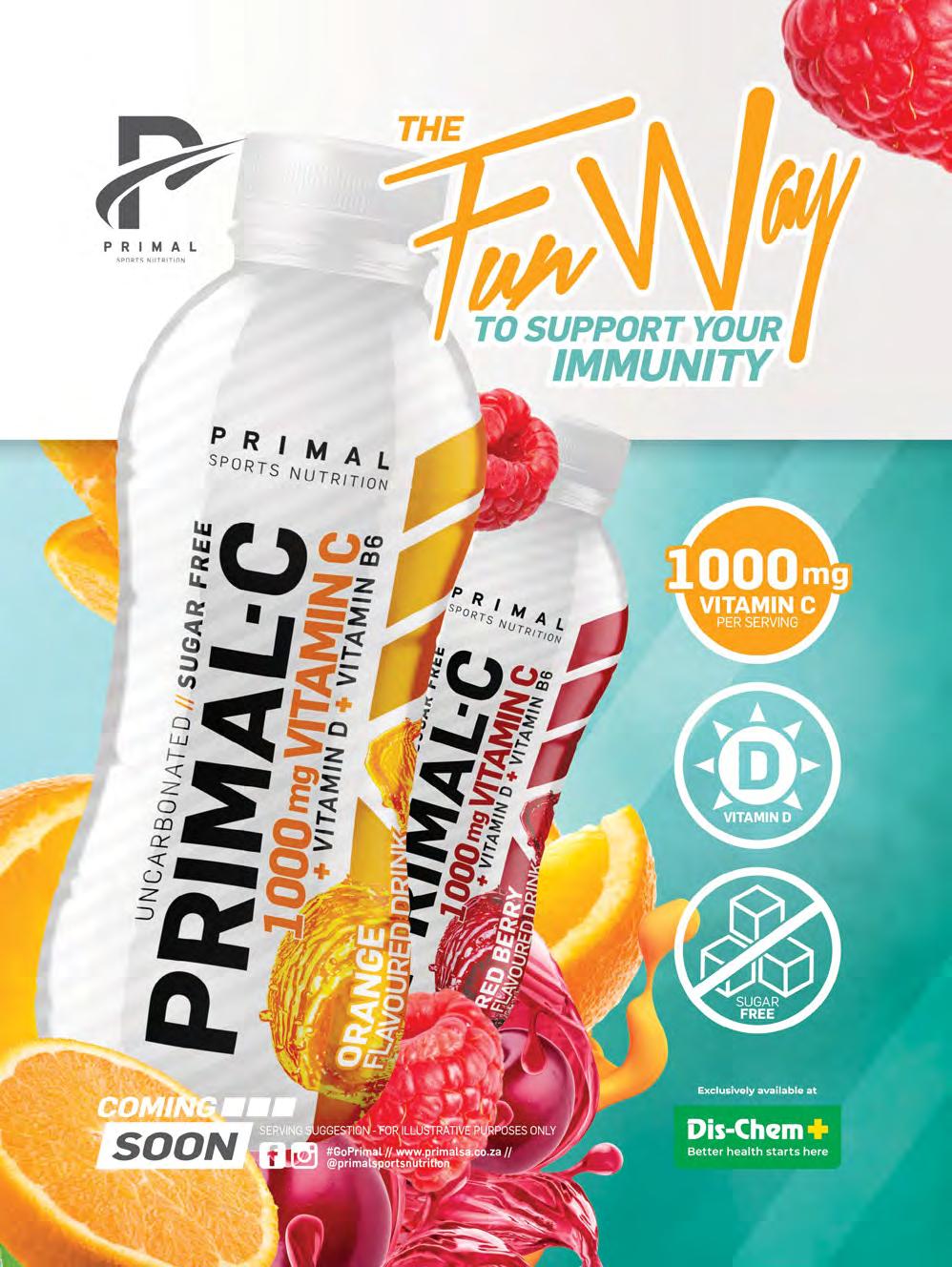

A 30-year study that followed 100,000 people examined the association between long-term dietary patterns and consuming ultra-processed foods with healthy ageing. The findings show that following a plant-based, nutrientdense diet with moderate amounts of healthful animal-based foods may significantly enhance healthy ageing.
*Study published in the Nature Medicine journal.
A new study found that cold water plunges improved cell recycling (autophagic) and the programmed removal of dead cells (apoptotic), which promotes cellular health and enhances stress resilience. The participants (young men) underwent cold-water immersion at 14°C for one hour over seven consecutive days.
*Study published in Advanced Biology.
Deep breathing can improve your mood and reduce stress by stimulating the release of serotonin in the brain.
When researchers took belly fat samples from study participants, they found that the fat just underneath their skin (subcutaneous fat) of those who exercised regularly had important differences to those who didn’t. Specifically, their fat tissue had more blood vessels and the tissue was less rigid. There was also less inflammation.
*Study published in the journal Nature Metabolism.

A study published in Cell Reports Medicine found that better physiology and long-term health were linked to 1-2 bowel movements a day.
A new study by Japanese researchers uncovered links between specific types of foods and sleep quality. Those high in fibre and protein were linked to longer total sleep time and those greater in total energy, fat, and sodium negatively impacted sleep quality and duration.
*Study published in the Journal of Medical Internet Research.
“A NOURISHED BODY IS A HAPPY BODY.”
in this section




This creamy dairy milk is easier on the digestive system, giving those with lactose intolerance the ability to enjoy the taste of cow’s milk without digestive discomfort. Enjoy it in smoothies, cereals or your daily cuppa.


Supercharge your mornings with the dairybased PVM Cereal range, which includes PVM Energy Bar Cereal. Just add water for a quick, breakfast the whole family (ages 4+) can enjoy. These cereals are gluten-free and contain no soy flour or added colourants, preservatives or artificial sweeteners. Available in a range of tasty flavours including Original, Banana, Strawberry or Chocolate.


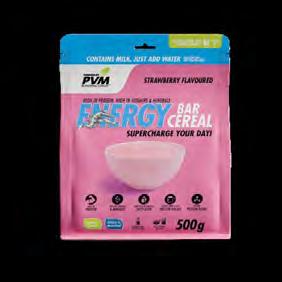


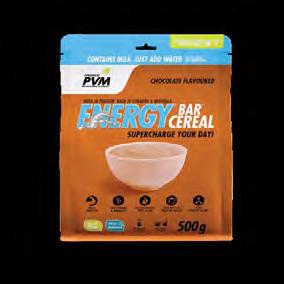

Power through your day with products formulated with SmartProtein3D™ — a unique blend of whey (fast-digesting), soy (moderate-digesting) and casein (slow-digesting) proteins. This trio delivers a sustained amino acid release, supporting muscle recovery, and keeps you feeling full for longer. Whether it’s a meal, shake or bar, the Futurelife range has your protein needs covered.

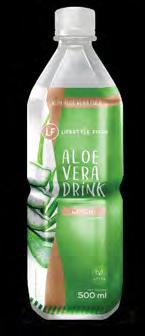


Enjoy refreshing hydration with a twist with Lifestyle Food Aloe Vera Water, infused with the natural citrusy tang of this succulent.
Tony Ferguson Pure MCT Oil is a clear, flavourless oil derived from coconut and palm kernel oils. MCTs offer a source of energy-dense fats that are rapidly metabolised. It’s the perfect addition for smoothies, salads or even your morning coffee to fuel your day.

Find everyday convenience with new Lifestyle Food Readyto-Eat Rice Cups. These pre-cooked rice cups are ideal for on-the-go meals or quick sides. All you need to do is heat and eat!


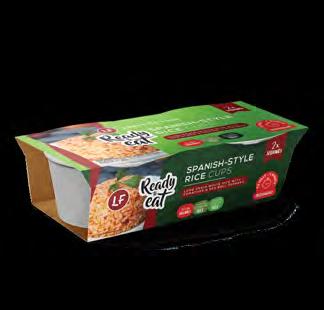
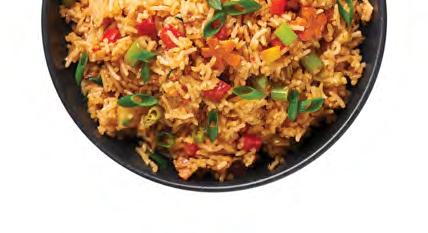


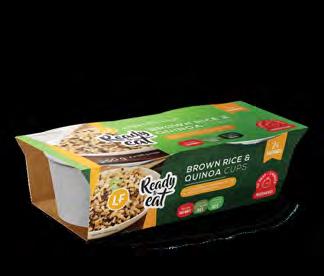
Discover the power of functional mushrooms with new Lifestyle Food Lion’s Mane, which is perfect for busy lifestyles.
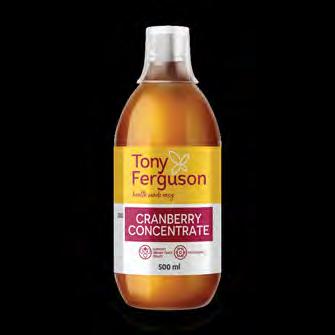

This Cranberry Concentrate is a tart, antioxidant-rich concentrate that may support urinary tract health and immune function. Simply mix with water or add it to your smoothies.
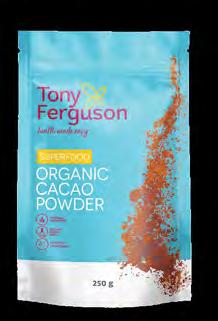

Rich, chocolatey and packed with antioxidants, Tony Ferguson Organic Cacao Powder is ideal for baking, smoothies or indulgent hot drinks. This is the ideal option to add a twist to your favourite recipes.
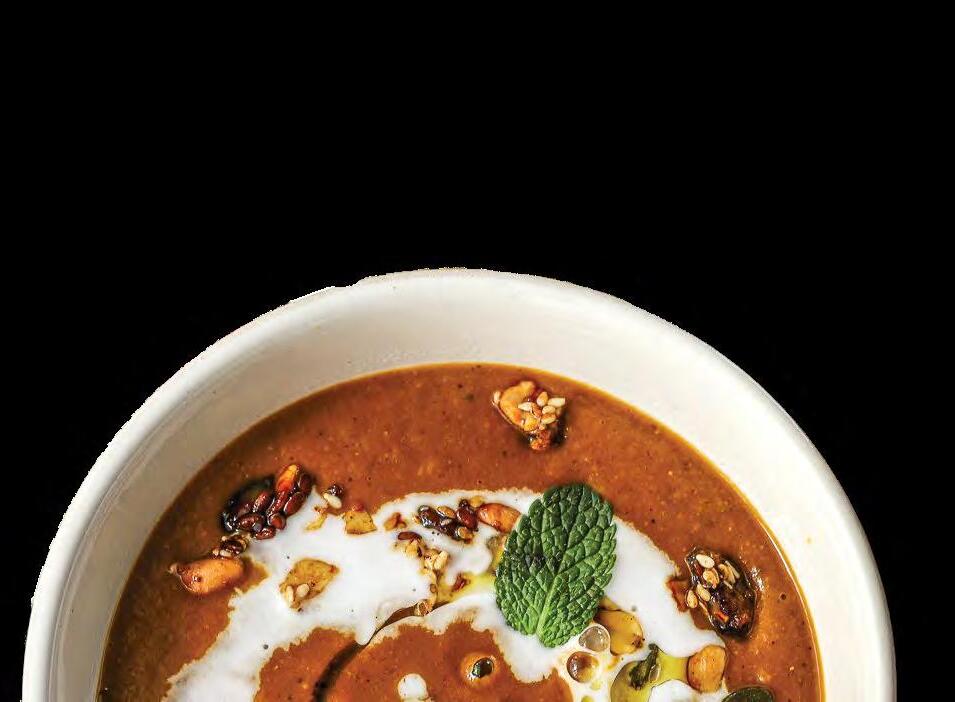
As the winter chill sets in, our bodies crave warmth and nourishment. These flavoursome and satisfying winter warmer recipes tick both boxes!

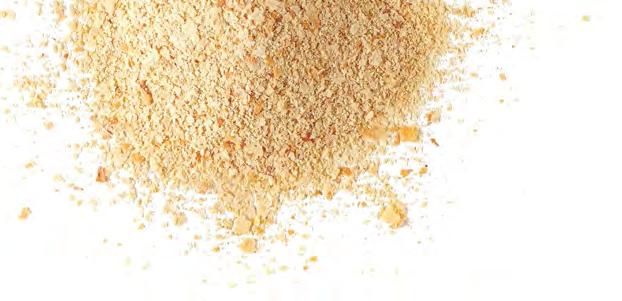
A nourishing, flavour-packed soup made with roasted red peppers, pumpkin and lentils - blended until velvety smooth and finished with a drizzle of Lifestyle Food Cumin Oil. Perfect for a cosy lunch or light supper.
Serves: 4
Ingredients
2 roasted red peppers (approx. 1 cup)
2–3 cups steamed or roasted pumpkin
1 ¼ cups coral lentils
1 tbsp miso paste
3–4 cups water or stock of choice


Lifestyle Food Black Cumin Oil can be used in food as a flavourful, slightly bitter seasoning oil, drizzled over salads, soups or dips for its earthy, peppery taste. It adds benefits thanks to its rich content of thymoquinone, essential fatty acids and antioxidants.
1–2 tbsp Lifestyle Food Nutritional Yeast
1 tsp garlic powder
3/4 cup Lifestyle Food Coconut Milk
Salt and pepper, to taste
Ingredients to serve
Lifestyle Food Cumin Oil
Lifestyle Food Honey
Lifestyle Food Coconut Milk
Roasted seeds
Fresh herbs
Hemp seeds
How to make it
Add all the soup ingredients to a large pot. Bring to a simmer and cook until the lentils are soft. Transfer the soup to a blender and blend until silky smooth. Serve warm, topped with roasted seeds, a swirl of coconut milk and fresh herbs. Finish with a drizzle of cumin oil and enjoy.



Ginger is excellent for digestion and may assist in alleviating bloating, indigestion and nausea, which can be exacerbated by heavy winter meals or rich holiday foods.


A creamy, comforting blend of butternut, carrots and warm spices - this golden soup is rich in flavour and goodness. Made with Tony Ferguson Ginger Powder and Turmeric Powder, it’s the perfect immune-boosting bowl for any time of year.
Serves: 4
Ingredients
1 medium red onion
2 cups steamed or roasted butternut
1 cup chopped carrots
1 cup canned butterbeans, dry lentils or canned chickpeas
1 tsp Tony Ferguson Ginger Powder
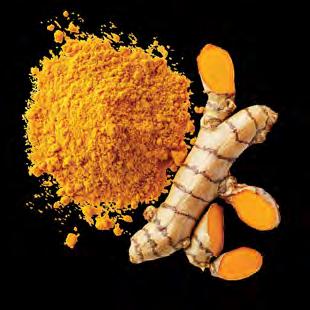
1 tsp Tony Ferguson Turmeric Powder
1–2 garlic cloves, or garlic powder/flakes
Olive oil for frying
400ml coconut milk or regular cream
2–3 cups vegetable stock
Salt and pepper, to taste
How to make it
In a large pot, heat a drizzle of olive oil and sauté the onion with ginger, turmeric and garlic until fragrant. Add the butternut, carrots, legumes, coconut milk or cream, and stock. Simmer until all vegetables are tender and cooked through. Let the soup cool slightly, then blend until smooth and creamy. Serve warm with toasted soy seeds or croutons, fresh herbs and an extra drizzle of cream.

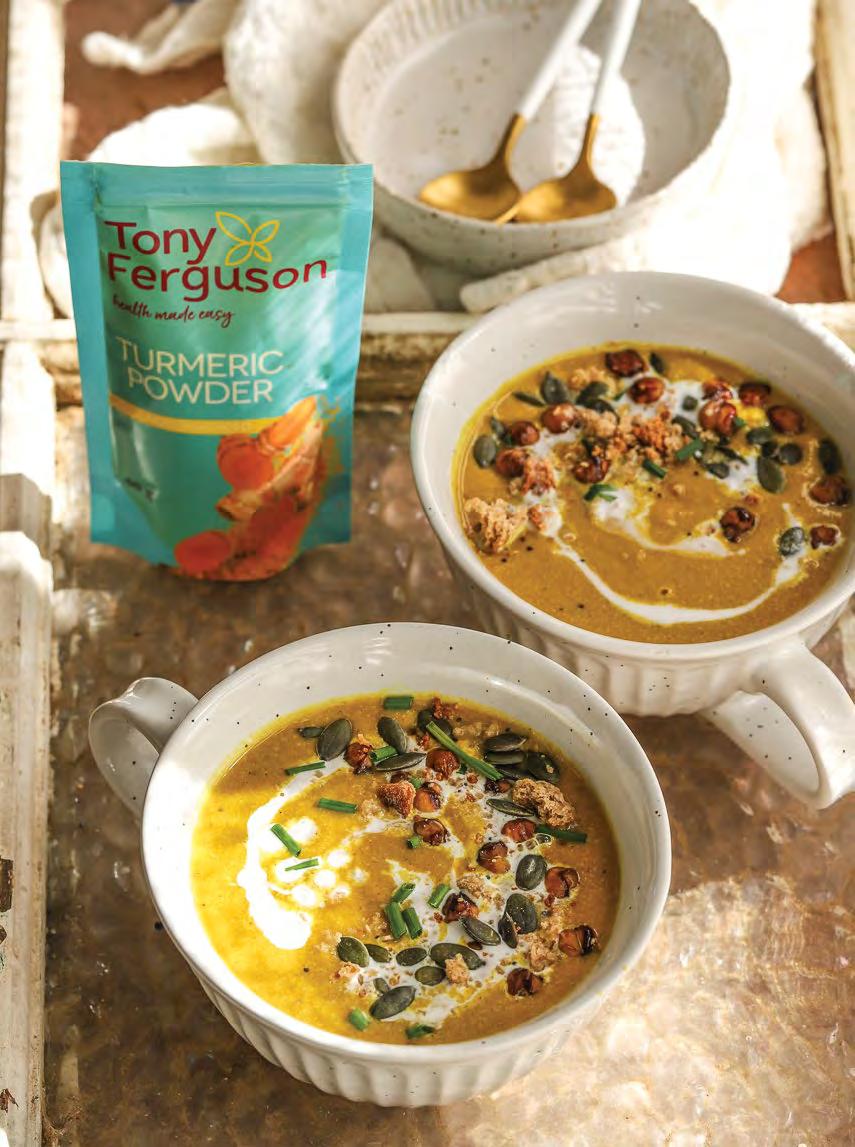

LIFESTYLE RECIPES


Serves: 1-2
Ingredients
1 scoop Lifestyle Food Bone Broth powder
1–2 tbsp Lifestyle Food Honey
1–2 tsp Lifestyle Food Cacao Powder
1–2 cups milk of choice
How to make it
Add the bone broth powder and cacao powder to a mug. Stir in the honey and a splash of hot milk, then whisk until smooth and well combined. Heat or froth the remaining milk and pour it into the mug. Mix well and enjoy warm.

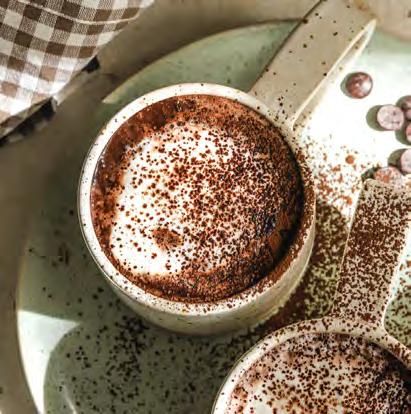
Vitamin C boosts immunity, supports skin and heart health, enhances iron absorption and acts as a powerful antioxidant that helps protect the body from disease.


Serves: 1
Ingredients
1 x 10ml Biogen Vitamin C Liquid Shot
1 glass cold water
Ice cubes
Orange wedge, for garnish
Pomegranate arils, for garnish
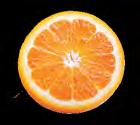

How to make it
Pour the Biogen Vitamin C Liquid Shot into a glass of cold water. Add a handful of ice cubes. Garnish with an orange wedge and a few pomegranate arils. Stir gently and enjoy chilled!
Meal prep not only saves time and money, but it also helps you make healthier choices throughout the week “
“

One of the most important truths is that you can’t outtrain a bad diet! That’s why the kitchen is your battlefront when waging war against weight management. Whether you’re starting a transformation to lose 20 kilos, or simply want to shed some fat for a slimmer physique, these 5 kitchen hacks can help you get there.
Preparation is the key to sticking to your weight loss diet or transformation plan because, as the popular motivational quote states, “if you fail to prepare, prepare to fail”.
Meal prep not only saves time and money, but it also helps you make healthier choices throughout the week as you don’t have to resort to unhealthy substitutes like takeout or convenience foods. Cooking meals in advance and portioning food into containers ensures you always have a meal ready when you’re supposed to eat. It also removes the guesswork at mealtime, letting you go about your day without worrying about preparing fresh meals from scratch each time, which isn’t realistic in today’s time-strapped lifestyle.
Simply invest a few hours on the weekend and again in the middle of the week cooking larger portions and dividing them into batches. A popular approach is batch cooking on Sundays and Wednesdays.
Prepare batches of different base ingredients, like vegetables or a large bowl of quinoa or brown rice, which are ideal to whip up salads or poke bowls or serve as a side dish. You can also prep entire meals and freeze them.
Researchers found1 that people who stored foods and beverages such as sweets, refined breakfast cereals and fizzy drinks on their kitchen counters weighed 9-12 kilos more than people who kept these items out of sight.
An even better idea is to create cheat-free kitchens If an unhealthy treat or nogo food item is not in your kitchen or pantry cupboard, you can’t munch on it when those cravings hit.
So don’t buy refined and processed foods or items that are loaded with sugar. Rather stock up on complex carbohydrates like brown and wild rice, rolled oats and quinoa over processed and refined easy-cook oats, white rice, pastas and breads.
You can also use these and other better-for-you ingredients and the numerous recipes available on the Dis-Chem website to create satisfying treats that can replace sweets and chocolates in
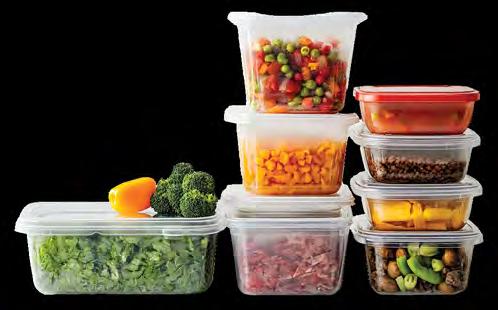

Don’t depend on calorie- and sugar-laden sauces and creams to flavour your meals. Many sauces, even seemingly healthy ones, can be high in added sugars, unhealthy fats and calories.
Rather use a variety of natural herbs and spices to add depth and different taste sensations to your meals. Herbs and spices offer a wealth of flavour without adding significant calories, sugar or sodium. They can also provide antioxidants and other health benefits.

Turmeric contains curcumin, a powerful anti-inflammatory and antioxidant compound.
1 carb portion = A cupped hand 1 protein portion = Palm of your hand 1 portion of grains = A clenched fist 1 portion of veggies = Two clenched fists
Feng shui your refrigerator by decluttering and reorganising your perishable foods. People usually grab things they can see, and food tucked away in drawers – usually your fresh fruits and veggies – tend to get forgotten.

DO THIS: Place the foods that you want to eat more of, such as fresh fruits and vegetables, lean meats, eggs and hummus, at eye level in your fridge so you’re more likely to grab these first when you’re hungry.
By making your most perishable items easiest to see, which are usually fresh, natural whole foods, you will start to eat healthier and waste less food.

Dishing up your meals in a smaller plate or bowl can help you keep portions in check and eat fewer calories overall.
Study findings2 support the concept that plate size distorts our estimates of meal size, causing us to eat more. For instance, in one study3, older children consumed 52% more cereal when served in a larger bowl.
“ Dishing up your meals in a smaller plate or bowl can help you keep portions in check and eat fewer calories overall “

Dishing up using smaller utensils, like a teaspoon instead of a dessert spoon, can also help reduce your total calorie intake.
If you don’t have access to a small plate, you can use these handy cues to estimate the appropriate portions to ensure you don’t overeat.

GETTING THE PLANT-BASED PROTEIN BASICS RIGHT

Our understanding of plant-based nutrition has evolved significantly, with growing recognition that plant-based sources can be just as effective as animal protein.
While vegetarian and vegan lifestyles are still emerging trends, it’s encouraging to know that a well-planned, predominantly or fully plantbased diet can fully support human nutritional needs.


RESEARCHED SHOWED...
Brown rice protein, which has a near-complete amino acid profile, was equally effective at building and maintaining muscle compared to dairy-derived whey.
People choose to follow a plant-based diet for various reasons. With environmental and ethical concerns being a major driver, others do so for religious practices, with more people choosing to go meat-free for the potential health and performance benefits.
One potential health benefit relates to the impact that animal products can have on inflammation.
Animal protein sources naturally contain compounds that are associated with inflammation, whether they were commercially farmed or organically reared. The way we cook meat can also increase the food’s inflammatory profile. Research2 shows that red meat intake is associated with higher levels of inflammatory markers like c-reactive protein (CRP), even when controlling for other dietary and lifestyle factors. The study also found that a high whole grain intake reduces CRP. As such, reducing your meat intake with a plantbased diet can help to limit or reduce inflammation, which has various potential health and performance
benefits. These include better recovery, reduced oxidative cell damage, lower disease risk and improved skin condition and brain function.
Research is also helping to debunk the notion that animal protein is superior to plant-based sources.
In one study2, researchers at the Florida International University showed that brown rice protein, which has a near-complete amino acid profile, was equally effective at building and maintaining muscle compared to dairy-derived whey.
These results also emerged in a study3 that compared the effects of whey and rice protein on body composition among “healthy resistance-trained males”.
Following eight weeks of daily 24g doses of rice or whey protein coupled with resistance training, study participants achieved “similar changes in body composition and performance outcomes”.
Research4 also suggests that diets higher in plants are associated with lower risks of chronic diseases, including cardiovascular disease.

High in protein, with a complete amino acid profile, and a good source of branchedchain amino acids (BCAAs).
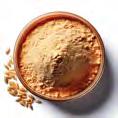
An incomplete protein (does not contain threonine, and has relatively low levels of lysine) but is rich in BCAAs. Also rich in fibre and antioxidants.

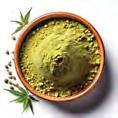

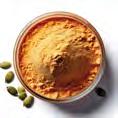
A complete protein with all EAAs that is highly bioavailable, and contains high amounts of glutamine and arginine.
A good source of protein, with a complete amino acid profile, although with less lysine than soy.
A complete protein source. High in fibre, omega-3s and antioxidants.
Contains all nine EAAs but is technically considered an incomplete protein due to levels that do not meet minimum requirements6
Whatever your reason for choosing to get some or all of your protein from plants, there are a few important tips to consider to make a successful transition and ensure you reach your protein goals.
Start by gradually replacing a few animal protein sources with plant-based alternatives. This could take the form of meat-free Mondays or opting for one plant-based meal a day to start.
It’s easier than ever to do so with the abundance of meat and dairy alternatives available at food retailers.

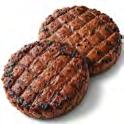
You can generally find plantbased alternatives such as faux-schnitzels or nuggets at supermarkets and speciality stores.
These substitutes generally contain ample plant-based protein to ensure you hit your macros, while also making it easier to replace animal protein with an alternative that has a similar taste and texture.
Add these products to your shopping list of natural whole foods sources like whole grains, nuts, seeds, beans and legumes. Another easy win is swapping dairy-based protein powders for a plant-based product for your shakes or use in your favourite smoothie, pancake, muffin or protein ball recipes.










Don’t completely change the meals you enjoy eating, or the flavours you’ve come to know and love. Rather spend time researching how to sub plantbased ingredients that have a similar taste and texture profile to their meaty counterparts. For example, sub the beef in spaghetti Bolognese with lentils or make a chickpea curry instead of a chicken dish. This approach means you don’t need to completely reinvent how you eat, and the flavours will remain familiar. This combination increases the likelihood that you’ll succeed in eating more plants.

Most plant-based sources are considered incomplete proteins because they do not have all the essential amino acids your body needs. However, this doesn’t mean they are inferior.
While certain plant proteins have gaps in their amino acid profiles, you can combine sources to create a complete profile to provide your muscles with everything they need to grow and recover.
The trick is knowing which incomplete protein sources –

known as complementary proteins – to combine to create a complete amino acid profile, ensuring you get everything your body needs to support muscle repair and growth.
Active Females:
1.4–2.0 grams per kg of body weight per day Adjusted slightly lower due to typically lower muscle mass, but still sufficient for muscle maintenance and performance.
Active Males:
1.6–2.2 grams per kg of body weight per day for strength training, bodybuilding or endurance sports.
The recommended daily protein intake per kilogram of body weight varies by activity level and gender. For active individuals, these are the general guidelines.
It is critical to understand the concept of derived protein when aiming to get the bulk or all of your protein from plants.
The recommended dietary allowance (RDA) of protein for a healthy adult with minimal physical activity is currently 0.8g of protein per kilogram per day (g/kg/day)5. Active individuals require more, with RDA requirements between 1.4‐2.0g/kg/day6.
You can often achieve that target with smaller animal protein portions than with plant foods. For instance, getting 22g of derived protein requires a 100g steak or 250g of black beans.


Then there’s the issue of digestibility. Animalbased proteins like whey, eggs, milk and beef are highly bioavailable, which means 94-99% of their protein content is digested and absorbed7
However, your body tends to absorb significantly less plant protein. For example, various types of dry beans and millet have low protein digestibility of 75–79%6 due to the presence of fibre and lectins, which can inhibit the absorption of some of the protein and other key nutrients.
This increases the total volume of plant-based foods we need to consume to derive sufficient protein to meet our daily requirements. That means, depending on your plant protein sources, you might need to eat more plant foods to meet your daily protein intake requirements.
A study8 that highlighted important considerations for active vegetarians underscored the role that supplements can play in a plant-based diet by stating that well-planned, appropriately supplemented vegetarian diets appear to effectively support performance. Supplements make it easy and convenient to cover your amino acid basis by combining multiple sources together in a single product to provide a complete profile. This ensures you get everything you need for muscle repair and recovery, enabling you to get the plant-based protein basics right.

WHEN COLD AND FLU SEASON ARRIVES EVERY YEAR, MANY PEOPLE TURN TO NATURAL REMEDIES TO GIVE THEIR IMMUNE SYSTEMS AN EXTRA EDGE.
Beyond the supplement and selfmedication aisles at your local Dis-Chem Pharmacy lies a selection of foods and drinks, including honey, herbal teas, and superfood powders, that may help support immune function, reduce inflammation, and help you recover from illness.
Honey is a natural product that may offer various nutritional and immuneboosting benefits.
While these benefits vary based on the source and manufacturing methods used to produce it, honey typically contains various
DEHYDRATION - WHICH IS COMMON IN WINTERcan impair immunity and delay recovery
vitamins and minerals1, including vitamin C, B vitamins, calcium, copper, iron, magnesium, manganese, phosphorus, potassium and zinc.
Other nutrients found in certain honey products include amino acids2, antioxidants, and plant compounds like propolis3, which contains a flavonoid called pinocembrin, giving it various health supporting properties.
Furthermore, honey’s natural enzymes produce hydrogen peroxide4, which helps to fight the bacteria that can cause infections.
Raw, unfiltered honey, in particular, is packed with antioxidants and trace nutrients. These properties make honey a popular home remedy to ease sore throats or coughs especially when added to a warm herbal tea.


have immunesupporting properties that can help your body fight off infection

Raw, unfiltered honey, in particular, is packed with antioxidants and trace nutrients
Herbal teas do more than offer warming comfort during the colder months. Many plants and herbs used to make these teas, like rooibos, chamomile, hibiscus, and ginger contain nutrients and compounds that may offer immune support.
Various studies suggest that it is the polyphenolic compounds (catechins and theaflavins) found in herbal teas that are associated with numerous beneficial health effects. The antioxidant effects of these compounds help to reduce inflammation and reduce the risk or help treat various conditions5
For instance, rooibos and hibiscus teas are rich in antioxidants, which may help reduce inflammation while ginger tea is

often used for its anti-inflammatory properties and ability to ease nausea.
Oolong tea is rich in polyphenols, particularly theaflavins and thearubigins, which may help reduce cell damage and inflammation, with studies6 suggesting it possesses antimicrobial effects.
The calming effects of chamomile can help promote sleep quality7, which is essential to support the immune system.
Superfoods are foodstuffs that are exceptional in their nutrient density, providing various vitamins, minerals and antioxidants. When included as part of a balanced diet, research affirms that superfoods can have beneficial effects on our health8
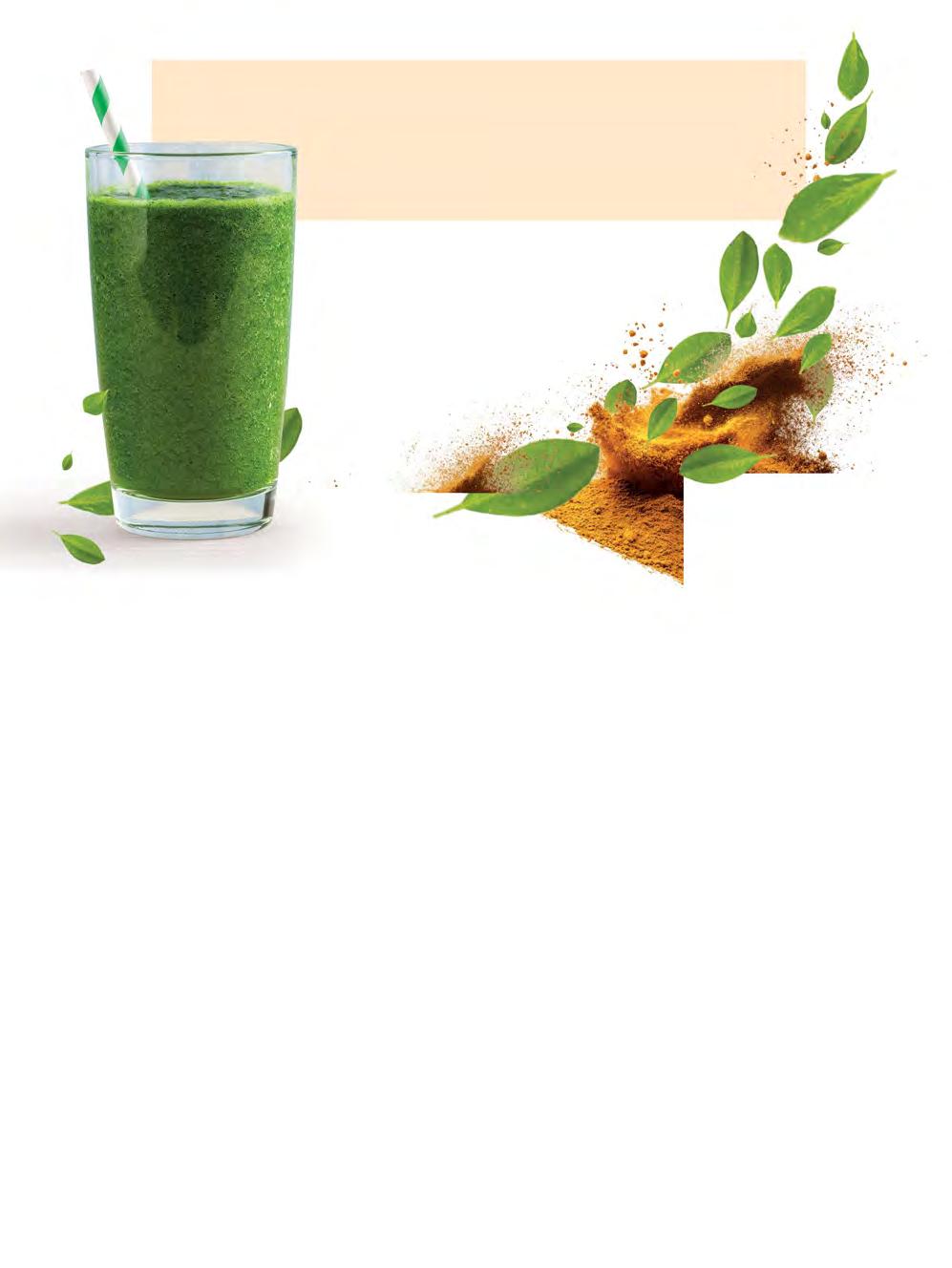
These foodstuffs are mostly plant-based items, including fruits, vegetables, seaweeds, algae, spices, herbs, and other plantbased items, such as blueberries, nuts and seeds, leafy greens, chia seeds and ancient grains.
Superfood powders are a convenient and effective way to boost your nutrient intake and benefit from the nutrient density contained in these foods.
These products are typically made by drying (or dehydrating) and grinding the most nutritious parts of plants, such as the roots, leaves and flowers, to preserve their vitamins, minerals, and phytochemicals.
While these potent powders should not replace healthy whole foods, they offer nutrient-dense, antioxidant-rich products that support your overall diet, with potential benefits such as immune system support and improved gut health and function.
Functional superfood products include numerous natural plants in concentrated powder form, such as spirulina, moringa, maca, matcha, barley grass, hemp seed, cacao and wheat grass powder. These powders offer a convenient way to add a nutrient boost to smoothies, shakes, juices, and other recipes.
Staying properly hydrated is one of the simplest yet most overlooked ways to support your immune system and recover faster when you’re under the weather.
Dehydration, which is not uncommon in winter, can impair immunity and delay recovery9. As such, drinking sufficient water, ideally enriched with electrolytes, doesn’t just quench your thirst — it plays a critical role in immunity and healing.
As your lymphatic system plays a key role in your immune defences10, responsible for transporting white blood cells and removing toxins, waste, and pathogens, it is important to ensure lymph fluid can move freely throughout the body. However, when you’re dehydrated, this system slows down.
Furthermore, your barrier defences, which include the mucous membranes in your nose, throat, and respiratory tract, require water to stay moist and
effectively fulfil their front-line immune defence function by blocking pathogens like bacteria and viruses.
Dry mucous membranes, often caused by dehydration, are more susceptible to irritation and infection and can make cold and flu symptoms worse by causing congestion.
Proper hydration helps thin mucus, making it easier to expel, and reduces congestion while keeping airways moist, which may ease coughing and irritation.
In addition, your gut needs adequate water to support your microbiome, which also plays an important role in your immune function11
Combining these natural foodstuffs with immunesupporting supplements, a nutritious diet, and a lifestyle that prioritises sufficient sleep, recovery, regular exercise, stress management and proper hygiene creates a solid foundation for a more resilient immune system.
*To view references for this article, please visit www.livingfit.co.za/issue26/references or scan the QR code on page 7.

HEALTH
CONSIDER THESE 3 SUPPLEMENTS FOR ADDED IMMUNE SUPPORT THIS WINTER


WHEN IT COMES TO IMMUNEBOOSTING SUPPLEMENTS, IT IS WORTH LOOKING BEYOND THE VITAMIN AND MINERAL AISLE
“YOUR BODY HEARS EVERYTHING YOUR MIND SAYS.” – NAOMI JUDD “
Glutamine is the most abundant amino acid in the body and is used in numerous internal processes. It is particularly important to the immune system as your body needs glutamine to produce and replicate specific cells. In fact, immune cells consume glutamine at a similar or often greater rate than glucose. However, immune cells cannot produce this ‘non-essential’ amino acid themselves.
Your muscle cells produce glutamine from branched-chain amino acids (BCAAs), which include valine, leucine and isoleucine.
Providing more of the building blocks your body needs to produce glutamine, particularly during an infection, can help ensure that you have sufficient glutamine to support your immune cells.
Glutamine is almost exclusively made by muscle cells, which also consume a significant amount for recovery and growth, but during an infection your immune system will need more glutamine.
Boosting glutamine levels is especially important for athletes who train hard or at high volumes as high training loads often lead to immune suppression by decreasing circulating glutamine levels.
These heightened demands make glutamine a conditionally essential amino acid – that means it is considered essential during periods when your body needs more of it, like when you experience higher stress (physical, mental or emotional) levels or during an illness.
That’s why giving your body extra glutamine from a supplement, especially when you are fighting an infection, is another way you can support your immune system this winter.
And science proves how supplementing with BCAAs can boost glutamine levels, like a clinical trial published in the journal Medicine and Science in Sports and Exercise. Researchers measured the effectiveness of BCAAs in maintaining circulating glutamine among triathletes and found that those who consumed BCAAs before and after the trial maintained glutamine levels, whereas those from the placebo group showed a reduction of 22.8% in glutamine concentration after the competition.
This post-competition drop in glutamine levels may make athletes more prone to illness following a major race or event.
You can get BCAAs from standalone supplements or from protein products, including whey and plant-based options.
* To view references for this article, please visit www.livingfit.co.za/issue26/references or scan the QR code on page 7.
While widely known for their role in intestinal and digestive health, the beneficial bacteria that reside in your gut called probiotics perform various important roles in your body’s immune system.

A growing body of research shows that these tiny yet potent microbes produce cytokines (cell signalling molecules in the immune system) and antimicrobial proteins that help to destroy pathogens like viruses and harmful bacteria when they enter our systems.
And certain probiotics break down prebiotic fibre into short chain fatty acids that play a role in stimulating immune cell activity. Studies have also linked probiotics to broader immunesupporting roles such as allergy prevention, skin and urinary tract health, and oral health. LF
The term ‘superfood’ was popularised in the 1990s and is used to indicate a special category of food with superior nutritional properties1 While the term does not have an official definition, with no scientific, regulatory or legal description proposed by food safety regulations, superfoods typically refer to foodstuffs and supplements that can provide nutrients in high quantity2.
SUPERCHARGE YOUR NUTRITION WITH
T he name of the superfood game is nutrient density, with superfood powders offering a concentrated blend of ingredients to easily and conveniently boost your nutrient intake.



Superfoods include various whole foods and ingredients that contain an abundance of micronutrients, like vitamins, minerals and antioxidants.
When included as part of a balanced diet, research affirms that superfoods can have beneficial effects on health1. Various superfoods also deliver this nutritional density with fewer calories per serving, which makes them popular among health- and weightconscious shoppers. These foodstuffs are mostly plant-based items, including dried fruits, vegetables, seaweeds, algae, spices, herbs and other plant-based ingredients such as blueberries, nuts and seeds, leafy greens and ancient grains.
However, some superfoods aren’t widely available in whole form at retail stores or greengrocers. In an effort to promote better nutrition and make healthy eating more convenient, supplement and health food manufacturers developed various superfood powders.
These products are made from the roots, leaves and flowers of certain fruits and vegetables, which are dehydrated and finely ground into powders.
While these potent powders should not replace a healthy whole-food diet, they offer health-conscious consumers nutrient-dense, antioxidant-rich products that support your overall diet, with potential benefits such as increased energy, stress management,
immune system support, gut health and improved skin, hair and nail health. Common superfoods found in powder form at Dis-Chem include various products in the Lifestyle Food and Tony Ferguson ranges, such as wheatgrass, maca, spirulina, moringa, chlorella, hemp seed, matcha, barley grass, cacao and wheat grass powders.

While we can get these nutrients from whole foods, which is always first prize when it comes to healthy eating, healthconscious cooks value the convenience superfood powders offer.
We can use these powders to simply and conveniently boost the nutritional content of smoothies, breakfast bowls or post-workout recovery shakes, offering a quick and easy way to increase our daily nutrient intake.
They are also great additions to baking and other conventional recipes, offering interesting tastes and colours that turn indulgent treats into functional delights. You can boost bread recipes with flaxseed or chia powders to enhance the texture and nutritional profile, or give your muffins a makeover with added matcha and turmeric powder for additional antioxidants and vibrant colours.
These features and benefits make superfood powders ideal for those who live busy lifestyles but don’t want to compromise on the nutritional quality of their diets, or those who struggle to eat enough fruits and vegetables.








FIBRE IS THE UNSUNG HERO OF GUT HEALTH; SUPPORTING DIGESTION, STABILISING BLOOD SUGAR AND KEEPING YOU FEELING FULL AND ENERGISED ALL DAY LONG.
Dietary fibre is a vital part of any balanced eating plan because our bodies need it to support healthy digestion and feed the beneficial probiotic bacteria in our gut. As such, it is indispensable to overall gut health and optimal function. But in today’s fast-paced world, where convenience often trumps nutrition, our overreliance on processed and fast foods can result in a fibre deficit.


While recommendations around adequate dietary fibre intakes differ around the world and by age group, it is widely recommended that we get 25-30g or more daily4
We should get most of our fibre from natural sources, with this complex carbohydrate found in plant-based foods like fruits, vegetables, whole grains and legumes.
According to research1, the average Western diet only provides about half the recommended daily amount. We can experience various issues without sufficient fibre in our diets, from poor digestion and constipation to diarrhoea and irritable bowel syndrome (IBS) due to an increase in bowel transit time.
From a weight management perspective, fibre promotes feelings of fullness, reducing cravings to aid weight loss or maintenance, and slowing sugar absorption, preventing spikes and crashes in glucose levels. Research also suggests that dietary fibre might protect us against heart diseases, hypertension and certain cancers2
For women experiencing menopause, eating a fibre-rich diet is particularly important as hormonal shifts during this time can significantly impact digestive health, increasing the risk of constipation.
Sufficient dietary fibre can also support weight loss and is important for female health, with research3 showing that sufficient soluble fibre “is associated with a significantly reduced risk of breast cancer among premenopausal women”.
Most plant foods contain a mix of two types of fibre, namely soluble and insoluble.
Soluble fibre dissolves in water, forming a gellike substance in the digestive system that helps slow digestion, enhancing nutrient absorption.
Soluble fibres include pectin, beta-glucans, gums and mucilage. Beneficial sources include oats, barley, citrus fruits, legumes, including beans and lentils, and vegetables like carrots and Brussels sprouts.
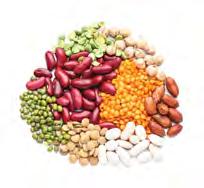

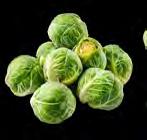
Insoluble fibre does not dissolve in water but plays an important role in digestion by adding bulk to the stool, which helps promote regular bowel movements.
You find insoluble fibre in whole grains like wheat bran and brown rice, cruciferous vegetables such as broccoli and cauliflower, and some fruits. *








Beyond digestion, fibre also plays an important role in our gut microbiome, serving as food for the probiotic bacteria colonies that live in our digestive systems.
A diet rich in prebiotics prevents constipation, improves nutrient absorption and boosts the immune system5.
Many forms of soluble fibre are prebiotics. These include fructooligosaccharides (FOS), found in onions, garlic and bananas, inulin from foods like chicory root, Jerusalem artichokes and onions, and galactooligosaccharides (GOS), which we get from breast milk and some plant foods.
Resistant starch, found in unripe bananas, cooked and cooled potatoes, and legumes, is considered both a soluble and insoluble fibre and is an important prebiotic.
While primarily insoluble in water and resistant to digestion, with a low water-holding capacity, this form of fibre also has soluble fibre characteristics, feeding probiotics in the lower digestive system (the colon).
WHAT YOU’LL NEED:
1 cup unsweetened almond milk (or any milk of choice)
1 ripe banana
½ cup frozen mixed berries
1 tbsp psyllium husk
1 tbsp chia seeds (optional for extra fibre)
1 tbsp honey or maple syrup (optional)
Ice cubes (optional for thickness)
Add all ingredients to a blender. Blend on high until smooth. Let the smoothie sit for 2–3 minutes to thicken slightly (psyllium husk expands with liquid)
“Most people eat less than half the recommended amount of dietary fibre” DID YOU KNOW

The best way to get sufficient fibre in all its forms and fight the fibre deficit is to make fibrous carbs a cornerstone of your daily diet.
Start introducing a wider range of fruits and vegetables into your diet and slowly increase your natural fibre intake to avoid potential digestive discomfort, such as excess gas or constipation.

Simply add fibre supplement powders to foods like breakfast cereals or take a capsule every morning with your meal.





A soluble fibre supplement can also prove useful to increase your daily fibre intake, especially for those struggling to meet their daily needs. Simply add fibre supplement powders to foods like breakfast or smoothies or take a capsule every morning with your meal.
When adding a fibre supplement to your daily diet, it is important to drink sufficient water to aid digestion.
From a supplement perspective, it is not always possible to get all the nutrients we need from food, especially when detoxing as we often need extra support.
By understanding the importance of fibre and taking steps to increase your intake through whole foods and supplements when necessary, you can improve your gut health and digestion.
It is best to consult with a healthcare professional or registered dietitian before starting any new diet or adding a supplement to your plan, especially if you have any underlying digestive issues or other health conditions.
MCT oil provides a quick, easily digestible source of energy that supports mental clarity, weight management, and endurance, especially for those on low-carb or ketogenic diets.


VITAMIN B: Bananas contain vitamin B6 (pyridoxine), vitamin B9 (folate), vitamin B1 (thiamine), vitamin B2 (riboflavin) and vitamin B3 (niacin)

VITAMIN C: Apples contain about 8% of the daily value
VITAMIN C: Oranges contain 70mg (more than 100% of the daily value)
is the foundation needed to build immunocompetence – your immune system’s ability to resist and control infections – because your immune system relies on numerous vitamins and minerals to function properly.
These micronutrients function as immunomodulators, altering your body’s immune response by supporting different activities, such as immune cell production or barrier function.
It is important to get these micronutrients through a diet that consists predominantly of natural foods, with supplements offering a convenient and effective approach to address any deficiencies in the vitamins and minerals our immune system needs.
Addressing nutrient deficiencies through dietary changes or supplements can enhance resistance to infection and recovery with better immune function1

Your immune system is a complex network, and each vitamin and mineral plays a unique role in keeping it functioning at its best. From boosting cell production to strengthening your body’s defences, these key nutrients are essential for optimal health. Let’s delve into the specific benefits of vitamins A, B, C, D and E, as well as carotene, selenium, zinc, iron, choline, carnitine, inositol and coenzyme Q10, to understand how they contribute to a robust immune response.
Selenium: An important trace element that supports antioxidant defence and modulates immune responses6. It is also involved in immune cell production7
Beta-carotene: Supports immune cell activity in the body, with research7 showing that beta-carotene supplementation can increase base levels of T-lymphocytes and immune system natural killer cells.
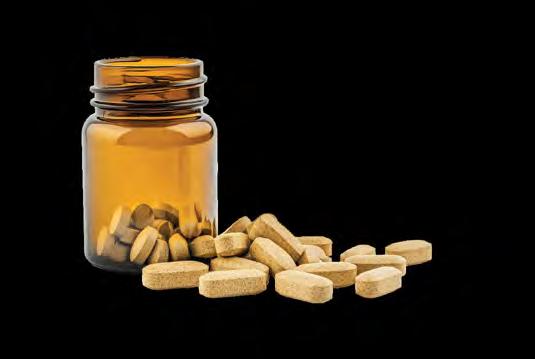
Coenzyme Q10 (CoQ10):
Supports immunity by acting as a , protecting cells and immune system components from damage caused by free radicals, crucial role in energy within immune cells8.
Iron: Essential for the production of red blood cells, which carry oxygen throughout the body, and regulating immune cell function, particularly in the gut9
Choline: Regulates the inflammatory response of immune cells through its antioxidant action10
Carnitine: Research11 shows that taking high doses of L-carnitine stimulates immune system function and improves neutrophil and macrophage function.
Zinc: Zinc functions as a co-factor for important enzymatic reactions involved in the antioxidant defence system, making it essential for a healthy immune response. Studies12 link zinc deficiency with a decline in lymphocyte function, which compromises immunity.
* To view references for this article, please visit www.livingfit.co.za/issue26/references or scan the QR code on page 7.
Vitamin A: Crucial for maintaining the integrity of mucous membranes, which act as a barrier against pathogens. It also supports the development and function of immune cells like T and B cells.
B vitamins: Produce cells involved in the immune response. Vitamins B6 and B12 are involved in numerous internal biochemical reactions related to optimal immune function.
Vitamin B2 (riboflavin) helps produce antibodies and is essential for energy production and antioxidant activity.
Vitamin B5 (pantothenic acid) is converted into coenzyme A, which is essential for many cellular processes, including the production of antibodies and inflammatory cytokines. Studies2 also suggest that vitamin B5 may play a role in stimulating the activity of immune

cells like macrophages and might contribute to maintaining the health of mucous membranes, which act as a physical barrier against viruses and bacteria entering the body.
Vitamin B3 (nicotinamide) helps to activate the innate immune system, potentially increasing its effectiveness against pathogens while supporting white blood cell (phagocyte) activity to help destroy bacteria and other harmful particles.
Vitamin C: Immune cells require vitamin C to protect them from free radical damage. Certain immune cells also require vitamin C to function optimally. As such, this vitamin is highly concentrated in immune cells and is consumed quickly during an infection. However, the body cannot synthesise vitamin C, which means we need to get enough from food and supplements. Studies3 show that vitamin C can also
reduce the severity and duration of colds.
Vitamin D: Functions as an immune system modulator4 to regulate its response and various functions. Specifically, vitamin D reduces levels of inflammatory proteins called cytokines and helps to increase levels of antimicrobial proteins such as B lymphocytes and killer T cells that destroy invading germs and viruses. Vitamin D supplements can help to compensate for a lack of exposure to sunlight during winter as we cover up or spend more time indoors.
Vitamin E: Boosts immune cell production, including the B-cells that produce antibodies to fight bacteria5. Vitamin E also acts as an antioxidant, protecting immune cell membranes from damage by free radicals, and produces proteins and other key mediators in the immune response.
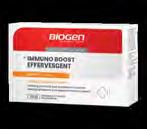




You can find many of these vitamins and minerals as a single source product or combined in immunity complexes that blend these research-backed micronutrients to support immune system health and function.
You can shop a wide range at your local Dis-Chem for a convenient and effective way to meet your nutritional demands during the winter cold and flu season.


How should I adapt my training approach through my menstrual cycle?
Sandra via social media

AWOMAN’S MENSTRUAL CYCLE CAN CREATE CHALLENGES AROUND MAINTAINING A REGULAR TRAINING PLAN AND DIET BUT CAN ALSO CREATE OPPORTUNITIES TO MAKE BETTER STRENGTH AND FITNESS GAINS DUE TO FLUCTUATIONS IN HORMONE LEVELS.
The sex hormones involved in female reproduction, such as oestrogen and progesterone, play a major part in how you feel, how easily you build muscle and recover, and your perceived effort.
WHAT IF YOUR STRONGEST GYM DAYS ARE WRITTEN INTO YOUR CYCLE?
Discover how to train with your hormones for peak performance all month long
The correct form of exercise and workout intensity can also impact your body’s hormone levels, which can help to decrease symptoms and improve your mood. Conversely, exercising too intensely at the wrong time in your cycle can amplify your symptoms and leave you feeling drained.
The key to training through every phase of your cycle is understanding the process and adapting your approach to make it more comfortable when you’re not feeling your best while capitalising on phases when you feel strong and energetic.
The textbook menstrual cycle usually lasts for 28 days. However, this timeframe is highly individualised, spanning anywhere from 21-35 days depending on numerous factors.
The menstrual cycle consists of four distinct phases driven by oestrogen and progesterone. These phases include:
1. Menstruation phase:
This marks the start of your cycle and usually lasts 4-6 days. During this phase, hormone levels are low, your body has realised it is not pregnant and starts shedding the uterine lining to prepare for the next cycle.
2. Follicular phase: This phase starts once your menstruation phase ends. Oestrogen levels start rising and peak on day 14, culminating in a burst that results in a surge in luteinising hormone (LH) on day 15, which initiates ovulation.
Understanding each phase in your cycle empowers you to shift your approach, choosing the right workouts and foods to improve your performance, decrease your injury risk and possibly manage symptoms. For most women, training through your period is daunting and uncomfortable, but it is something you need to deal with at least once a month. While a few lucky ladies will hardly miss a beat in their usual training
3. Ovulation phase: This phase lasts for 24-48 hours and marks the middle of your cycle. At this stage, the ovaries release an egg into a fallopian tube, which awaits fertilisation.
routine, many have to grind through lethargy, water retention, bloating and irritability while also trying to keep cravings at bay.
Faced with these feelings and lack of energy, it’s understandable that many women choose to skip training in the week or so leading up to their period. However, there is little evidence to suggest that your period directly influences your performance.
4. Luteal phase: The final phase of your cycle is when progesterone emerges as the prominent hormone. While oestrogen levels remain stable but high, this increase in progesterone increases body temperature in preparation for fertilisation. If this doesn’t happen, levels of both hormones decrease abruptly. This phase ends with the start of the next period
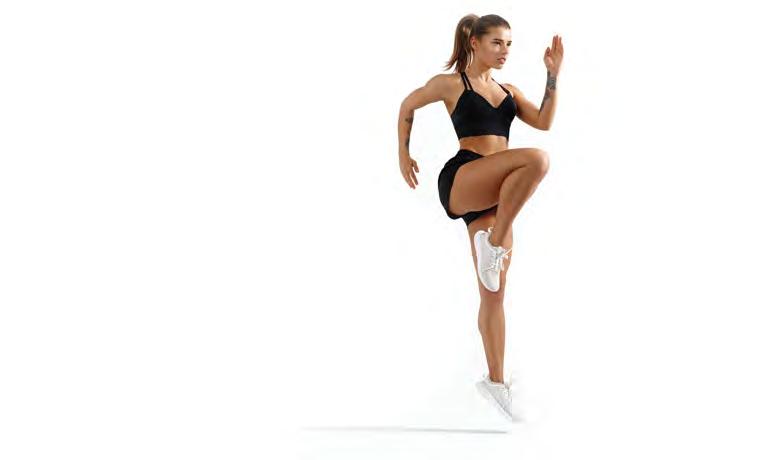
For example, researchers1 in Turkey surveyed 241 elite athletes about how their menstrual cycle affected their performance. While nearly 75% of the women who responded said they felt worse just before menstruation, 63% said that their pain decreased during training and competition, and 62% said that they believed their performance didn’t suffer during their period.
Menstrual phase
(Days 1–5): Lower energy and strength; it’s usually best to focus on light movement or rest.
Follicular phase (Days 6–13):
Strength and energy start to rise — great for building intensity.
Ovulation (Days 14–16):
Peak strength, coordination and performance — ideal time for heavy lifting or high-intensity training.
Women will generally feel their most energetic during the follicular phase. In the days directly after your period ends, oestrogen levels are low and are only starting to rise.
This is the best time to get in your most intense training sessions.
Your mood, energy and strength levels are usually at their best, making it the ideal time to engage in heavy weight lifting or plyometrics in the gym, or high-intensity interval training (HIIT) workouts on the road or bike.
During the ovulation phase, testosterone levels peak, which should leave you at your strongest and fastest.
During the luteal phase, your body temperature rises, which boosts your metabolism and you burn more calories than at any other time during your cycle This increase has been measured at anywhere from 2.5-11% above normal energy expenditure2
If you add intense, prolonged
exercise to the mix, you’ll raise your metabolism even higher, which can leave you feeling more exhausted. This increased energy expenditure is also linked to the rise in appetite and cravings during this time.
When oestrogen and progesterone levels are highest during the follicular and luteal phases (from days 14-28), keep your intensity low as high-intensity training can increase the production of these hormones.
Engage in activities like walks, low to moderate weight training with higher reps, and yoga and Pilates to improve flexibility and mood, manage stress and possibly reduce symptoms like cramps.
When you start menstruating, keep exercise light and listen to your body. If you don’t feel up to exercising, take a rest day, but there is little risk associated with exercising during the menstruation phase.
phase (Days 17–28): Gradual decline in energy; consider moderate to lighter training, especially as you approach menstruation.
It is also worth noting that the fluctuations in progesterone and oestrogen, and their differing concentrations, impact your energy metabolism.
During the initial phases, you become more fat efficient, as oestrogen makes you more insulin sensitive3, making you less likely to store fat and more efficient at metabolising fat stores for energy.
Progesterone, on the other hand, makes you more insulin resistant4, which can make it easier to store fat and can hamper efficient energy production. Higher progesterone concentrations during the luteal phase also affect fluid balance, which initially results in a loss of water and electrolytes, and can leave you dehydrated and listless.
However, as you transition from the luteal phase back to the follicular phase, progesterone levels drop and you may experience premenstrual water and electrolyte retention, which can cause bloating.
Your menstrual cycle isn’t a barrier to fitness - it’s a blueprint. By tuning into what your body naturally wants to do at different times of the month, you can work with your hormones instead of against them.
*To view references for this article, please visit www.livingfit.co.za/issue26/references or scan the QR code on page 7.


WELLNESS
While known for its ability to improve power and training capacity among men and women in their prime, there are also many good reasons for older generations to consider this super supplement.
Creatine is traditionally associated with bodybuilders and athletes in power sports like weightlifting and any activity that requires short bursts of speed – think sprinting, soccer, cycling or rugby. However, women who are serious about their performance have increasingly embraced this supplement in recent years, and it seems like more of the general population could also benefit, especially women.
As the most studied supplement on the market, research continues to confirm that creatine is safe and welltolerated by both men and women, with benefits reported in both sexes1. In fact, some research suggests that it could offer women more benefits because they typically store less creatine – 70–80% less – than men2 due to their lower muscle mass (we store creatine predominantly in muscle cells and some in the liver).
One study2 found that a creatine supplement may be particularly important for women during menstruation, pregnancy and post-partum due to “hormone-related changes” in how the body uses and produces creatine.

Another critical period in a woman’s life is before, during and after menopause. About 1.5 million women experience the menopause transition each year, which often involves troublesome symptoms, including hot flashes, insomnia, fatigue and joint pain3
A woman’s body also undergoes several hormonal changes during menopause, with a decrease in oestrogen levels the most significant. These changes can significantly impact a woman’s body composition through muscle loss. Oestrogen plays a crucial role in maintaining muscle mass, but levels naturally decline with age and accelerate during menopause. The resultant loss in muscle mass (a condition known as sarcopenia) can begin as early as your thirties, with women losing 3-8% of their muscle mass per decade, with that rate increasing after 604
As such, women often experience a decrease in muscle mass and strength during this period in their lives without proper interventions.
About 1.5 million women experience the menopause transition each year, which often involves troublesome symptoms, including hot flashes, insomnia, fatigue and joint pain3
Studies show that combining a creatine supplement with resistance training can benefit perimenopausal, menopausal and postmenopausal women by helping to counter the loss in muscle, bone density and strength that typically accompanies the condition2
In one study2, researchers found that premenopausal women improved their strength and exercise performance when they took a creatine supplement.
Postmenopausal women who took higher doses (0.3 g/kg/d) also experienced benefits by developing more muscle and improving muscle function when taken alongside resistance training, which led to favourable effects on bone density.
Based on their findings, the researchers concluded2 that creatine “augments body composition and bone mineral density, particularly in postmenopausal females”. But creatine doesn’t only help build muscle. It also has a muscle-sparing effect. A
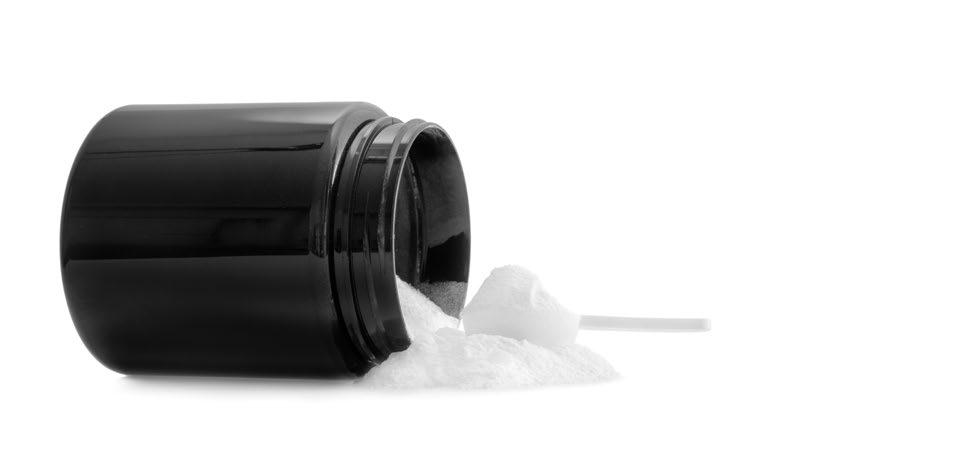
study5 that compared the myoprotective (musclesparing) potential of a creatine supplement to that of whey protein determined that “creatine supplementation appears to offer an element of myoprotection which was not observed following whey protein supplementation”. The ability to slow muscle loss and hang onto more hardearned muscle as you age is vital to maintaining your quality of life with better functional strength and mobility. There were also psychological benefits, as “pre-clinical and clinical evidence indicates positive effects from creatine supplementation on mood and cognition, possibly by restoring brain energy levels and homeostasis2”. These mental benefits included improved memory, reduced mental fatigue and a more positive outlook, which are important because women “may develop depressive symptoms and cognitive difficulties during menopause, which are more subtly and inconsistently linked to hormones3”. WE RECOMMEND



Navigating midlife changes? This quick checklist highlights common perimenopause symptoms. Understanding these signs can help you seek timely support and guidance.
Irregular periods
(longer, shorter, heavier, lighter)
Hot flashes or night sweats
Sleep disturbances
Mood swings or increased irritability
Vaginal dryness or discomfort
Changes in libido
Difficulty concentrating, or mindfog
Fatigue
Hair loss or thinning
Breast tenderness





Creatine is naturally found in small quantities in foods like red meat and fish, with creatine supplements a convenient and effective way to boost your intake.

Our body uses the creatine we get from food and supplements to support the energy production needed to fuel short and intense muscle contractions. With a limited amount of creatine stored in our muscle cells (which is more pronounced in women), boosting creatine stores with a supplement can increase the levels of creatine in muscles4

* To view references for this article, please visit www.livingfit.co.za/issue26/references or scan the QR code on page 7.
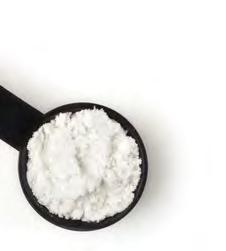
Creatine monohydrate is the most common form of creatine available today, and it is considered by many to be the most effective. Studies6 show that creatine monohydrate supplementation for 4–12 weeks increases muscle creatine content by 20–40%.
To reap the benefits of creatine, it is best to use it consistently with a cycled protocol. Always follow label recommendations on your preferred brand around dosing, but most recommendations are a daily dose of up to 5 grams, taken with water or a carbohydratecontaining beverage.
Before starting any new supplement, including creatine, it's advisable to consult with a healthcare professional, especially if you have underlying medical conditions or concerns about how it may interact with other medications or supplements you are taking.

Turning 40 isn’t a slowdown — it’s a powerful new chapter. By this time, most women have navigated big lifestyle shifts and are stepping into a phase of transformation, one that brings new insight, strength and the opportunity to prioritise health like never before.
Yes, your body is evolving — hormonally, physically and emotionally. But with these changes come chances to rediscover vitality, embrace strength and reimagine what wellness looks like. You might notice shifts in energy, metabolism, flexibility or libido, but you’re not losing momentum, you’re gaining wisdom.
This is also when signs of perimenopause can start to show: hot flashes, night sweats and subtle shifts in how your body responds. But instead of seeing this as a pause, it’s a powerful invitation to tune in, take charge and thrive.
Perimenopause, also known as the menopausal transition, is the period leading up to menopause when your body starts to make the natural transition towards the end of your reproductive years.
This phase typically starts in a woman’s 40s, but it can start as early as the mid-30s or as late as the mid-50s.
During perimenopause, the ovaries gradually begin to produce less oestrogen and progesterone. These hormonal shifts are responsible for the various symptoms experienced during this time, which include:
This phase can last anywhere from a few months to several years, with an average duration of about four years.
Considering HRT during perimenopause? Only a qualified medical doctor can assess if it’s right for you. Hormone levels fluctuate wildly in this stage, so testing and professional monitoring are key. Self-diagnosis won’t cut it. Get expert guidance to make informed, safe choices for your long-term health and wellbeing.
Menstrual irregularities (longer or shorter than normal, lighter or heavier, irregular or missed periods).
Hot flashes and night sweats.
Sleep disturbances and fatigue.
Mood changes, such as irritability, anxiety or depression.
Hair loss or thinning.
Vaginal dryness and discomfort during intercourse.
Changes in libido
Urinary problems, such as urgency or incontinence.
Cognitive changes, like difficulty concentrating or “brain fog”.

Changes in bone density.
Changes in cholesterol levels.
Perimenopause officially ends and ‘the change’ starts when you have gone 12 consecutive months without a menstrual period.
This signifies that the ovaries have essentially stopped releasing eggs and producing significant amounts of oestrogen and progesterone. Once in menopause, women experience the permanent end of menstruation and the inability to become pregnant naturally. For many women, the bothersome symptoms associated with the hormonal fluctuations of perimenopause gradually subside in the years following menopause as the body adjusts to the lower hormone levels.
However, some symptoms, such as hot flashes, may continue for a while after menopause, although they often decrease in frequency and intensity over time.
Lower oestrogen levels after menopause can increase the risk of certain health conditions, such as osteoporosis (decreased bone density) and cardiovascular disease.
During perimenopause and menopause, women can take several proactive steps to manage symptoms and enhance their overall health and wellbeing with lifestyle changes and medical treatments.

The important lifestyle changes relate to diet, exercise and supplements. Women should prioritise a balanced diet rich in fruits, vegetables, whole grains, lean protein and healthy fats.
Include calcium-rich foods like dairy, leafy greens and fortified products to support bone health and reduce the risks of osteoporosis, along with adequate vitamin D from your diet, sunlight or supplements to aid calcium absorption.
Limit processed foods, saturated fats, excessive sugar, caffeine and alcohol, as these can exacerbate some symptoms like hot flashes and mood swings, and also cause weight gain.
From an exercise perspective, general guidelines recommend engaging in at least 150 minutes of moderate-intensity or 75 minutes of vigorousintensity aerobic exercise per week.
Women going through perimenopause and menopause should also incorporate weight training to maintain bone density and muscle mass.
A study1 conducted by the University of Exeter found that resistance training (in the form of Pvolve exercise classes) could alleviate some of the physical issues that arise due to menopause, helping to increase energy, improve strength, mobility and balance, and deliver better health outcomes, like lower cholesterol.
The other lifestyle factors to consider include a supportive sleep routine, which can help manage night sweats, suitable stress management strategies to manage the mood changes and anxiousness common during this time, and quitting smoking, as it can negatively impact bone density and increase the risk of cardiovascular disease.


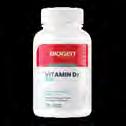
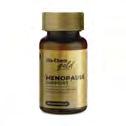
Supplements can also make it easier and more convenient to respond to the changes your body is going through during perimenopause and menopause.
Addressing bone mineral and muscle loss should top your list of priorities. Bone and joint support supplements that combine calcium and vitamin D support bone density while a daily protein supplement can help to slow muscle loss, especially when combined with weight training.
Supplement manufacturers also formulate menopause support products that combine key ingredients like vitamins, minerals and herbal extracts shown to support a healthy response to the natural changes that occur during menopause.
It’s important to remember that every woman’s experience with perimenopause and menopause is unique. Some may have mild symptoms, while others experience more significant changes that can impact their daily lives.

It is always best to consult with a qualified healthcare professional for individualised advice on lifestyle changes and medical interventions to manage or reduce the symptoms *
For more insights on the latest studies, expert advice and trusted guidance from medical professionals on this topic, scan the QR code. Stay informed, empowered and up-to-date with everything you need to know.

















































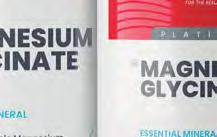


























































SUPPORT THYROID FUNCTION FOR MORE ENERGY, BETTER HEALTH AND A HEALTHY METABOLISM
Are you struggling to lose weight, lack energy or find it hard to get out of bed every morning, even after a long night of uninterrupted sleep? Are you forgetful, or do you struggle to concentrate during the day?
If so, you could be suffering from waning thyroid function. If left unchecked, undiagnosed or untreated, this condition can develop into hypothyroidism or, depending on the root cause, something as severe as Hashimoto’s disease.
The thyroid gland is located in the front of your neck, just below the Adam’s apple (larynx) and above the collarbone.
It wraps around the trachea (windpipe) like a butterfly, with two lobes (right and left) connected by a thin piece of tissue called the isthmus. The gland sits just under the skin and muscle, making it easy for doctors to examine during a physical check-up.
Hypothyroidism, also known as an underactive thyroid, is a hormonal system (endocrine) disorder in which the thyroid gland, which is located at the base of your neck, does not create enough thyroid hormones, including thyroxine (T4) and triiodothyronine (T3)1
While the disease is most common among women, it can affect anyone, with nearly five out of 100 Americans aged 12 years and older2 afflicted with hypothyroidism. However, most cases are mild or have few obvious symptoms. The condition can occur due to an imbalance along the hypothalamic–pituitary–adrenal (HPA) axis, which means the thyroid gland is not properly stimulated.
When working properly, the hypothalamus secretes thyrotropinreleasing hormone (TRH), which stimulates the pituitary gland to produce thyroid-stimulating hormones (TSH), which in turn stimulates the thyroid gland to produce and secrete mainly T4 and some T3.
A change in the structure and function of any of these organs or pathways can cause hypothyroidism. Thyroiditis, an inflammation of the thyroid gland, can also result in suboptimal function, with
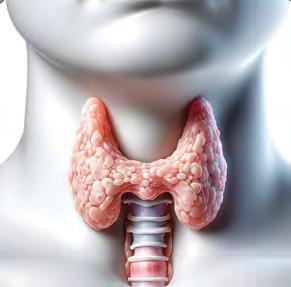
iodine deficiency another common cause of hypothyroidism1
Another, less common condition called secondary or central hypothyroidism occurs when the thyroid gland functions normally, but a person develops hypothyroidism due to abnormal pituitary gland or hypothalamus function1 HPA axis dysfunction is often associated with adrenal fatigue and cortisol dysregulation, which often results from chronic stress and an unhealthy lifestyle but has also been linked to other autoimmune diseases.
As thyroid hormones regulate energy metabolism, insufficient thyroid hormone may slow various metabolic functions. This may result in various mental and physical issues. For instance, sufferers can experience lethargy or fatigue, brain fog and memory problems, depression and cold sensitivity or intolerance. Common physical symptoms include uncontrolled weight gain, joint and muscle pain, dry skin, thin, brittle hair or fingernails, constipation, bradycardia (slow heart rate), high cholesterol, irregular menstrual cycles or a puffy face, feet and hands. The symptoms of hypothyroidism can vary from person to person, and some people may not experience any symptoms at all.





YOUR BODY
Fuel your thyroid with whole foods, iodine-rich ingredients and movement - your metabolism will thank you.
The best way to reduce your risk of hypothyroidism is to follow a healthy and active lifestyle that supports thyroid health and function. This approach should include a balanced diet that consists mainly of whole, unprocessed foods including fruits, vegetables, whole grains, lean proteins and healthy fats.
Including iodine-rich foods in your diet, such as seaweed, fish, dairy and iodised salt, can also assist thyroid function because the thyroid gland uses iodine to produce thyroxine (T4) and triiodothyronine (T3).
It may also help to limit foods that may interfere with thyroid function, such as cruciferous vegetables like cabbage, broccoli, cauliflower, soy products and peanuts.
Regular exercise and physical activity are crucial to help boost your metabolism, regulate hormone levels and maintain a healthy weight.
Additional ways to boost thyroid function include stress management by regularly using techniques like yoga, meditation or breathing exercises to reduce stress
levels, and prioritising adequate sleep to give your body time to recover and regulate hormones.
You can also improve your metabolism and balance thyroid function with a supplement like Slimz Thyroid Support.
Formulated to improve thyroid function by attaining a balanced metabolism, body temperature and healthy weight, these capsules can support weight loss, burn fat and increase your energy levels.
If you suspect that you suffer from poor thyroid function or hypothyroidism, it is important to consult with a healthcare professional for personalised medical advice and a treatment plan.
Hypothyroidism is a treatable condition most commonly addressed with medications that replace the thyroid hormone your body is not producing1. With treatment, most people with hypothyroidism can live normal, healthy lives.
Your doctor may also prescribe regular blood tests to monitor your thyroid hormone levels and identify potential problems early on for additional interventions.


Seaweed (eg. nori, kelp and wakame)


Fatty fish like cod, tuna and sardines are naturally rich in iodine

Eggs, especially the yolk, which contains most of the iodine

Iodised salt
Table salt fortified with iodine is an easy and effective way to get your daily intake

A revitalising blend of green tea and ginger created to support your wellness goals - naturally
Warmth. Wellness. Tony Ferguson


DANÉLLE MAKES HER MARK IN NPL BODY REV CHALLENGE
KID MEANT TATTOO ARTIST
DANÉLLE BREEDT HAD ALWAYS BEEN AWARE OF HER WEIGHT, WHICH FLUCTUATED WILDLY THROUGHOUT HER LIFE.
While she has always loved being active, Danélle didn’t always look the part because she struggled to find balance in her life, as her passion for her career as a tattoo artist often consumes her.
“I am incredibly passionate about what I do. However, my obsession with creating can cause intense stress, burnout and depressive episodes that often result in binge and mindless eating.”
As a result, Danélle constantly felt uncomfortable and overweight.
“My clothes wouldn’t feel or sit right, so I opted to just wear oversized items, which made me feel even bigger.”
It was also exhausting putting so much effort into training but not seeing consistent and maintainable results.
“I didn’t stick to a balanced nutrition plan and never understood that discipline is the key to success. I kept making excuses and did not prioritise my health and long-term goals over momentary happiness.”

Feeling incredibly overwhelmed, stressed and depressed, Danélle decided she needed to completely overhaul her lifestyle.
“I saw the NPL Body Rev Challenge and immediately thought that this was how I rebuild my life, mentally and physically, to become the person I want to be.”

Danélle always knew she had the potential to unlock a new, healthy, happy and focused version of herself; she just needed a structured approach and some accountability to build a sustainable active lifestyle while balancing her passion and time-consuming career.

AGE 25


“My husband held the same belief in me and encouraged me to enter the challenge, saying if there’s anyone who can win, it’s me. He encouraged me every step of the way.”
LIVES RANDBURG, JOHANNESBURG

CAREER TATTOO ARTIST
INSTAGRAM:
@DANNI_THETATTOOIST
FACEBOOK: DANELLE SNYMAN

Danélle says NPL provided incredible meal plans that taught her how to eat correctly without restricting certain foods.

“I chose meals off the NPL diet plan that I could prepare in advance, and made my priority sticking to the plan. As I started eating more balanced meals, I had fewer cravings and binges.”
“It felt extremely demotivating, until I compared the check-in photos.
At that moment I knew -
“The structure provided by the incredible meal plans and different options that NPL supplied took out all the guesswork and made the process easier.”

From a training perspective, Danélle focused on being more active by simply walking and lifting weights consistently. “Dedication to the goal was more important than motivation for me.”
Danélle ensured she got 10,000 steps a day and stuck to the NPL cardio recommendation of three 30-minute cardio sessions a week.
She also modified the training plan as she loves leg day, following a 3-day lower body and 2-day upper body split.
“The exercise programs were so easy to follow and not overwhelming. I set daily and weekly goals to stick to the plan and checked them off on a calendar every night.”
The step-by-step guide to success provided by NPL also included a supplement plan, which told Danélle exactly what to take and when to support her training and diet.
The process wasn’t without its challenges, explains Danélle, especially when the scale didn’t move between the third and fourth check-ins.
“It felt extremely demotivating, until I compared the check-in photos. At that moment I knew it was just a matter of trusting the process and the plan, because progress was not only defined by the scale.”
Her approach eventually paid off when Danélle was announced as the female winner in the NPL Body Rev Challenge 8.0.
While NPL provided a great platform, with all the tools and knowledge she needed, Danélle says the incredible support
- it was just a matter of trusting the process”
she got from her husband, friends and the other challenge participants helped her achieve her goal.
“I knew it would be a harder battle to win mentally than physically, but thankfully I had a lot of support when it got tough. Everyone was so involved in my well-being at every point of the challenge.”
Danélle says the online accountability community that NPL created for the challenge was a massive motivation.
“It was incredible to be part of the online community as contestants from all over were showing their progress and motivating each other. It was such a wholesome experience!”
Danélle is also thankful for online fitness and prep coach Simonne Paarman, who checked
After a few weeks, it became completely natural to have five meals a day, and this way of eating has become Danélle’s new lifestyle.
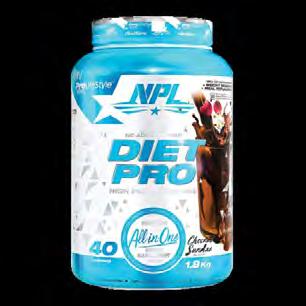

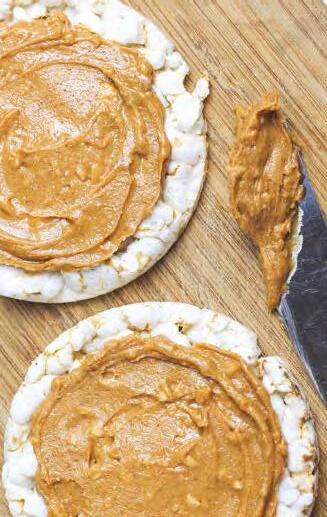

NPL Whey Slim with oats
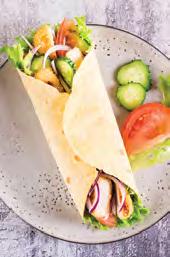
MORNING SNACK: NPL Diet Pro protein shake + 2 rice cakes with peanut butter
in on her weekly throughout the challenge and guided her through all the ups and downs.
Completing the12-week NPL Body Rev Challenge has transformed Danélle’s physical and mental health for the better and completely repaired her relationship with food.
“I am more confident and know how to apply balance to every aspect of my life. I no longer see exercise as a punishment, but a beautiful way to release stress and test myself, and ‘diet’ is not a negative word for me anymore. Food is fuel and the essential building blocks to a healthy body.”
More importantly, the process has shown her that you can achieve anything if you’re willing to work for it.

LUNCH: Chicken wrap

AFTERNOON SNACK: NPL Diet Pro protein shake + 2 rice cakes with peanut butter

DINNER: Chicken or lean mince and basmati rice
“And that’s the message I want others to get –you can also do it! It’s not the weight holding you back, you just don’t have a solid and sustainable plan. Take it day by day and you will see the results.”
Danélle says she is thankful for the journey as it pushed her out of her comfort zone. “As a result, I am now in a space where I feel in complete control of my time, my lifestyle and myself.”
FAVOURITE HEALTHY DISH: Chicken wrap
FAVOURITE EXERCISE: Bulgarian split
squats –they burn but they work!
MUST-USE SUPPLEMENTS: NPL Carni Lean
3000, NPL Thermo Cuts, NPL Night Time Burn, NPL Whey Slim Protein
TOP DIET TIP: Get a plan and stick to it!
NEXT GOAL: Build more muscle
Registrations for the next NPL Body Revolution Challenge open from 25 July - 22 August 2025. The 12-week challenge starts on 25 August 2025 Visit www.npl.za.com/pages/body-revolution for more info.

Eccentric (muscle-lengthening) bodyweight training benefits mental and physical health, suggests findings from a new study. Specifically, just 5 minutes of eccentric bodyweight resistance training a day delivered improvements in wellbeing, strength, and physical health markers.
*Study published in the European Journal of Applied Physiology
Muscle and fat are completely different tissues. You lose muscle from inactivity and gain fat from excess calories — but one never magically becomes the other.
Scientists have found that strength training for 90 minutes a week was linked to up to 4 years less in biological age, which could improve your lifespan.
*Study published in the journal Biology.

Recent research that looked at 15 studies from the past decade analysed what happens when healthy adults combine time-restricted eating (TRE), like the 5:2 diet, with regular exercise. Researchers found that people who combined these two practices lost more fat and reduced their body fat percentage over time more than those who only exercised.
*Study published in the International Journal of Obesity.
“NOTHING WILL WORK UNLESS YOU DO.”
What’s the best way to prepare my body for a heavy gym session?

IT IS ESSENTIAL TO PREPARE YOUR BODY AND MIND BEFORE AN INTENSE WEIGHTLIFTING SESSION BECAUSE IT NOT ONLY REDUCES YOUR INJURY RISK BUT CAN ALSO IMPROVE YOUR PERFORMANCE FOR BETTER GAINS.
Most gym-goers understand the need for a warm-up to improve blood flow and enhance joint mobility. By sending more nutrient and oxygen-rich blood to muscles, a warm-up increases muscle temperature, making them more pliable. When this happens, muscles become less prone to strains or tears under heavy loads. Warm-up exercises that focus on improving your range of motion also stimulate the production of synovial fluid, which lubricates your joints. This reduces friction and allows for smoother, safer movement during heavy lifts.
Synovial fluid is a clear, viscous fluid found in the joints of the body, particularly those that are freely movable such as the knees, shoulders, elbows, hips and fingers.
However, these are not the main reasons why a proper warm-up is so important. It is the impact that certain warm-up drills have on your nervous system that delivers the biggest influence on your performance in the gym.
Your nervous system controls muscle activation and coordination. A proper warm-up should “wake up” your nervous system, improving the communication between your brain and muscles, which is crucial for proper form and stability during heavy lifts.
Priming our neuromuscular system to fire optimally helps muscles contract when they’re supposed to -- and with greater force.
That’s why some light cardiovascular activity and a few static stretches before
your session won’t cut it when it comes to activating your muscles to achieve their full potential.
In fact, research shows that static stretching before exercise can reduce muscle power and force production. In one related study1, researchers reported that static stretches “negatively affected maximal strength and power performances irrespective of the participant’s age, gender or fitness level”. Based on the results, the authors recommended not to apply static stretching during a warm-up routine.
An example of a progressively more intense upper-body pre-workout activation warm-up would include:
Visit page 86 for a full pre-workout activation guide.
In the world of warm-ups, pre-workout activation drills are your go-to option. These movements focus on activating your neuromuscular system with specific exercises or drills that activate the right muscles in the right order so that they fire in the right sequence and with greater force.
These dynamic movements enhance the communication between your nervous system and your muscles to get your body functioning as an integrated system, which is the way it was designed to operate.
If we get this right, a pre-workout warm-up has the potential to improve performance across multiple aspects related to peak performance.
For instance, results from a study published in the Journal of Physical Education and Sport2 confirmed the effectiveness of a pre-warm-up exercise program on multiple muscle performance markers, including range of motion, countermovement forces and peak torque.
1. Arm circles
2. Band pull-aparts
3. Shoulder rotations with dumbbell
4. Walk-outs with press-ups
5. Plyometric push-ups
While pre-workout activation drills stimulate specific muscles, the aim is to target movement patterns rather than isolate specific muscles or muscle groups.
That’s why activation drills should be specific to the activity you’re about to perform.
These movement drills activate the neuromuscular system and the numerous muscles involved in a movement pattern to ensure primary movers – the muscles primarily responsible for creating a specific movement (also known as agonists) – and all the smaller stabiliser (aka accessory) muscles are ready to take
the strain and fire in sequence.
The aim of pre-workout activation is to gradually recruit more motor units with each progressive activation exercise to eventually get entire muscles or muscle groups firing on all cylinders. This requires gradually increasing the forces and contraction speeds of the activation drills we perform before a workout.
As such, a comprehensive pre-workout activation routine should consist of a combination of general mobility and dynamic movement-specific drills that progresses to movements that include some resistance or explosive plyometric movements to recruit more motor units.
*To view references for this article, please visit www.livingfit.co.za/issue26/references or
Keep your preworkout activation routine brief – no more than 10 minutes. The idea is not to fatigue muscles, so perform only a few reps of intense, explosive movements.
Focus on controlled movements and proper form.
Focus on both the contraction (concentric) and the lengthening (eccentric) phases of every drill. This approach should ensure you’re all fired up and ready to go for that first heavy rep!

GET THE MOST OUT OF YOUR WEIGHTLIFTING SESSIONS AND REDUCE THE RISK OF INJURY
While a general warm-up improves blood flow and joint mobility by increasing muscle temperature and synovial fluid flow, the most significant benefit comes from its impact on your nervous system.
A proper warm-up “wakes up” your nervous system, enhancing communication between your brain and muscles, which is vital for good form and stability when lifting heavy. WORKOUT
The following pre-workout activation drills are dynamic exercises that target movement patterns rather than isolated muscles, activating your neuromuscular system to ensure the right muscles fire in the correct order and with greater force. By gradually recruiting more motor units through progressively challenging mobility and movement-specific drills, including resistance or explosive exercises, you can prime your body for peak performance, improving range of motion, force production and overall muscle function


Stand tall with your arms extended straight out to the sides at shoulder height. Begin making small forward circles with your arms, gradually increasing the size of the circles. After 15–30 seconds, reverse the direction to backward circles.
FORM TIP: Maintain control and tension through the shoulders and upper back throughout the movement.
Hold a resistance band at shoulder height with both hands. Extend your arms in front of you, keeping them straight. Pull the band apart by squeezing your shoulder blades together and drawing your arms out to the sides. Pause briefly at full extension, then return slowly to the starting position.
FORM TIP: Focus on controlled movement and engaging the rear delts and upper back.

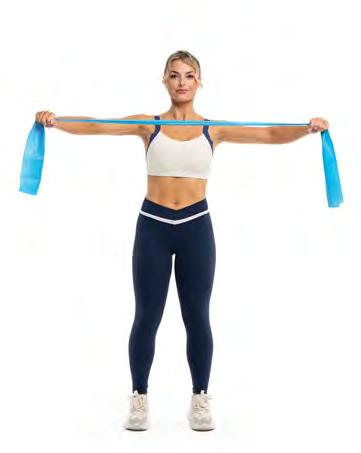
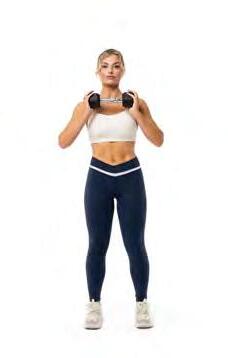
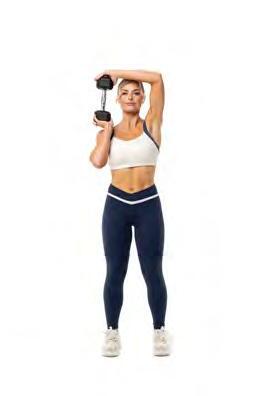

Hold a dumbbell at chest height with both hands on each end. Slowly move the dumbbell to your right ear, then behind your head, to your left ear and then back to your upper chest. Perform 10 in each direction.
FORM TIP: Keep the dumbbell in line with your neck when it is behind your head.



Stand upright then hinge at the hips to reach down and place your hands on the floor. Walk your hands forward into a high plank position. Perform a controlled pushup, then walk your hands back toward your feet and return to the standing position.
FORM TIP: Keep your core engaged throughout and avoid sagging through the hips.
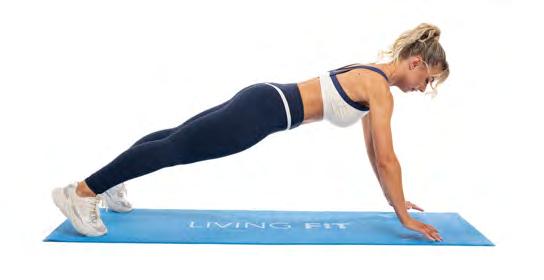
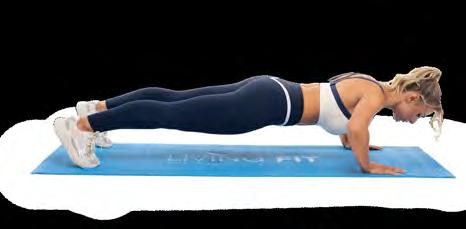
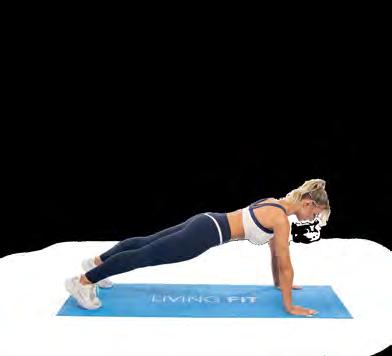
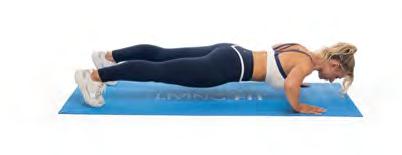

Begin in a high plank position with hands slightly wider than shoulder-width. Lower your body into a push-up, then explosively press upward so your hands briefly leave the floor. Land softly and immediately lower into the next repetition.
FORM TIP: Keep your core engaged and maintain a neutral spine to maximise power and control.


MATTHEW
STONE KNOWS HOW TO ROCK HYROX. HE LIVES AND BREATHES STRENGTH AND FITNESS, working as a coach for hybrid athletes while competing as a PUMA-sponsored elite athlete on the local and global circuit, racing some of the best athletes on the planet.
Matt has always been active, from competing in athletics and playing rugby at school to serious gym training and CrossFit. He says HYROX caught his eye due to its unique combination of endurance and strength.
“Blending elements of running and functional fitness into one demanding format offers a competitive yet inclusive environment, welcoming participants of all fitness levels and backgrounds. Each race constantly pushes me to challenge my personal limits, which fosters continuous growth and resilience,” explains Matt.
After deciding to make the transition from CrossFit competitions to HYROX, Matt shifted his focus toward specific endurance and stamina training.
“I adapted my strength workouts to prioritise more functional movements aligned with the race demands,” he explains.

“THE VALUE OF COMMUNITY AND CAMARADERIE STANDS OUT, AS SUPPORT FROM FELLOW ATHLETES FUELS MY MOTIVATION AND COMMITMENT TO THE SPORT.”
After competing in the inaugural Cape Town event, his performances earned him a role as a HYROX SA ambassador and a Dis-Chem Living Fit athlete.
Based on his experience so far, Matt says successful HYROX athletes typically possess a strong aerobic capacity, enabling them to sustain high-intensity efforts over time.
“They also have the ability to recover quickly between stations, maintaining performance throughout the race. Most importantly, they demonstrate mental toughness, pushing through fatigue when it matters most.”
A typical week of HYROX training for Matt includes 4-5 days of high-intensity interval training (HIIT) to build endurance and speed, complemented by 2-3 days of strength training to maintain power and functional strength.
“I reserve 1-2 days for active recovery, such as yoga or mobility work, to enhance flexibility and prevent injury.”
According to Matt, effective HYROX training hinges on consistency in training volume to build a solid aerobic base and strength foundation. “Incorporating race-specific simulations into their training helps athletes become familiar with the flow and demands of competition to better prepare for the pacing and structure of HYROX events.”
ATHLETE STATS:
NAME: Matthew Stone
CAREER: Hybrid Coach
AGE CAT: 30-34
SPONSORS: PUMA, HYROX SA & Dis-Chem Living Fit ambassador
INSTAGRAM: @Matthewstone
SHOE OF CHOICE: PUMA x HYROX Deviate Nitro 3




RICH IN CARBOHYDRATES, PROTEINS AND HEALTHY FATS SUPPORT ENERGY NEEDS AND RECOVERY.”
Matt says competing in HYROX races has highlighted the importance of mental preparation and resilience under pressure. “Each event provides lessons on adapting to new environments and unpredictable race conditions. The value of community and camaraderie stands out, as support from fellow athletes fuels my motivation and commitment to the sport.”
Pacing is another critical skill in HYROX races, asserts Matt.
“Athletes should start at a sustainable pace that allows for
MATT’S WEEKLY SUPPLEMENT STACK INCLUDES:
WHEY PROTEIN: Aids post-workout recovery and muscle repair.

consistency throughout the event. Monitoring your heart rate can help guide your effort and prevent burnout. Ideally, athletes should conserve energy early on to push harder and finish strong in the second half of the race.”
HYROX athletes also need to fuel their training and racing to go the distance, and support their recovery between training sessions with precision nutrition.
“Fuelling for a HYROX race
ELECTROLYTES: Essential for hydration and performance, especially during longer training sessions or races.
BCAAS: Consumed during workouts to support endurance and reduce muscle breakdown.
involves eating balanced meals rich in carbohydrates, proteins and healthy fats to support energy needs and recovery,” explains Matt. He supports his diet with intelligent supplementation, incorporating various products in and around his training and racing.
“When racing, a tailored hydration strategy is essential, especially given the length and intensity of the race. During competitions, quick energy sources like gels or chews help maintain performance and avoid energy crashes.”
“Each race pushesconstantly me to challenge my personal limits, which fosters continuous growth and resilience.”

Imatthewstone
When asked for his advice for aspiring HYROX athletes, Matt recommends that you focus on mastering technique before chasing speed.
“Embracing the process is key as progress takes time, and consistency pays off. Staying adaptable and listening to your body helps prevent injury and supports sustainable growth.”
When it comes to looking for that extra edge, Matt says carbon-plated shoes like the PUMA x HYROX Deviate Nitro 3 can offer advantages in terms of speed and efficiency, making them ideal for race day or speed-specific sessions.
“However, they should not replace proper training or solid technique. Their role is to complement performance — not to compensate for gaps in preparation.”


Follow his journey and get some training tips from a pro...
Crunches alone aren’t enough to build a stronger core that supports functional movement and helps prevent injuries.
The ab roller is an effective way to target the numerous powerful, functional muscles that make up your core, which include more than just your abs.

Dynamic trunk extension movements like an ab rollout require you to actively stabilise your core to stop your back from arching.
KNEELING AB WHEEL ROLLOUTS
Starting: Kneel on the floor and hold the ab wheel so that your arms form a 90-degree angle with your torso. Your hips should also be bent at a 90-degree angle.

How to do it: Engage your abdominals and keep them braced throughout the movement. Roll the wheel forward by slowly extending your hips and arms, opening up the 90-degree angles with your arms. Gradually stretch your arms out as far as you can while maintaining a neutral spine and pelvis.


These muscles perform vital roles in stabilising your spine and pelvis, which is essential for good posture.
From a performance standpoint, your core is where you generate your power. That’s why strong and functional core muscles help to create and transfer force throughout the body and also support more efficient movement.
And a strong core distributes the stresses imposed on your body during weight-bearing activities such as running or jumping, and protects your back under heavy loads when lifting weights.
Conversely, a weak core means that other muscles need to compensate by performing stabilising functions, even if they were not designed to do so. This creates weakness and inefficient movement patterns, which reduces strength and often results in injury.
Form tip: If your lower back drops when you roll out, it means that you are rolling out too far.
Starting: Stand holding an ab wheel using an overhand grip. Flex your hips and lower the wheel to the floor in front of your feet to support your weight.

How to do it: Roll out as far as you can in a controlled manner without your back arching. Keep your elbows slightly flexed during the extension. Hold for a count, then slowly roll the ab wheel back to the starting position. LF





tell me about creatine...
tell me about creatine dosage strategies ... tell me about creatine efficacy ... tell me about creatine and kidneys ... tell me about creatine use in youth ...
Creatine is one of the most extensively studied nutritional supplements available to athletes at every level.
Creatine offers anyone who is serious about their exercise performance and muscular development a cost-effective product relative to its many benefits.

Our body uses phosphocreatine (PCr), which we get from food and supplements, to help make ATP (Adenosine Triphosphate). Our body does this by combining creatine with Adinosine Disphosphate (ADP) to form ATP.
WHAT IS ATP? ATP is the main source of energy for short, intense muscle movements. Since our muscles can only store a limited amount of creatine, taking creatine supplements can
help boost those stores, leading to better physical performance. Studies1 show that creatine supplements can raise the levels of creatine and PCr inside muscle cells.
Creatine monohydrate is the most common form of creatine available today, and it is considered by many to be the most effective. It is basically creatine bound with water – each molecule is made up of 88% creatine and 12% water.
Numerous studies2 over the past three decades have shown that creatine monohydrate supplementation for 4–12 weeks increases muscle creatine and PCr content by 20–40%.
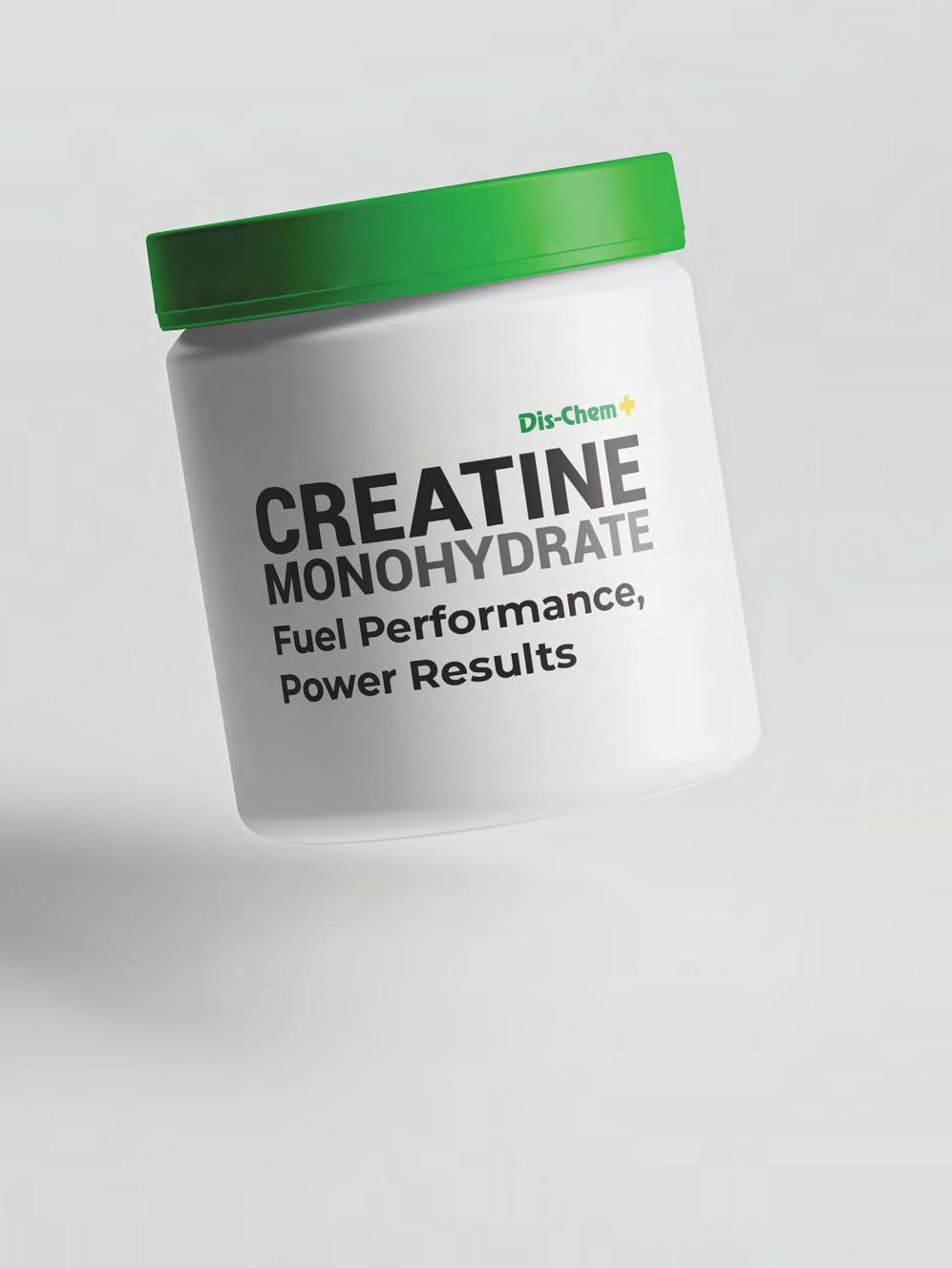
How: Creatine works by increasing high-intensity exercise capacity. According to the International Society of Sports Nutrition’s position stand3, “creatine monohydrate is the most effective ergogenic nutritional supplement currently available to athletes in terms of increasing high-intensity exercise capacity and lean body mass during training”.
How: Boosting creatine stores with a supplement enables you to sustain the intense short duration muscle contractions for longer during resistance training sessions.
By increasing strength, power and muscular endurance in this way, you can train harder for longer, which increases the stimulus muscle tissue needs to grow back stronger and bigger with the appropriate recovery and nutritional support. This enhanced work capacity delivers creatine’s musclebuilding benefits, rather than any direct effects on muscle protein synthesis (MPS), as is the case with supplemental protein.
How: The findings from the study, which were published in the journal Nutrients, suggest that the ability of a creatine supplement to support muscle growth runs deeper than its ability to generate functional strength.
According to the Australian researchers, observations from the study suggest that supplementing with creatine reduces the extent of muscle damage and/ or enhances the growth of the regenerating fibres. They suggest that the structural improvements are due to increased cell fluid volume that occurred in the earlier stages of the study, which may underpin the benefits observed in the later stages of recovery.

How: Research by a team of Australian scientists has shown that creatine may deliver a greater muscle sparing effect than whey protein.
In the study4 funded by AST Sports Science, a research team led by Matthew Cooke imposed controlled, chemically induced damage to the skeletal muscle tissue of lab rats to test the myo-protective potential of supplemental creatine (CR) compared to that of whey protein (WP).
CREATINE IS ONE OF THE MOST EXTENSIVELY STUDIED NUTRITIONAL SUPPLEMENTS AVAILABLE TO ATHLETES AT EVERY LEVEL. DID YOU KNOW

The study results showed that the creatine-supplemented muscles “displayed a greater proportion of non-damaged (intact) fibres and larger cross-sectional areas of regenerating and non-damaged fibres compared to CON (control) muscles at day 7 post-injury. At day 14 post-injury, CR-supplemented muscles generated higher absolute forces concomitant with greater contractile protein levels compared to CON and WP-supplemented muscles.”
Based on the findings, the researchers concluded that: “Creatine supplementation appears to offer an element of myoprotection which was not observed following whey protein supplementation.”

How: For endurance athletes, creatine can improve race performance, with a study5 published in 2023 determining that “creatine supplementation appears to be more effective at improving performances that require multiple surges in intensity and/or during end spurts, which are often key racedefining moments”.
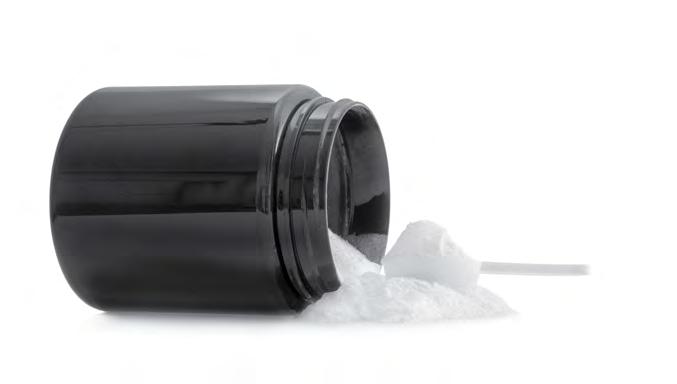
Over the years, researchers have examined the impact of creatine on renal function after some negative reports raised concern. To date, no compelling evidence of this was found.
According to Deminice et al (2013), creatine supplementation inhibited the increase of inflammatory markers in response to intermittent anaerobic sprint exercise.
Study findings also suggest that creatine can assist athletes in tolerating heavy increases in training volume as it helps with the enhancement of glycogen loading (Nelson et al 2001), while also promoting greater recovery (Cooke and colleagues, 2009) after an intense training session as athletes experience a decrease in inflammation while on a creatine protocol.

Reports of kidney damage associated with creatine use are scant6, with a meta-analysis7 of 200 non-duplicated studies concluding that “creatine supplementation does not induce renal damage in the studied amounts and durations”
However, creatine supplements should not be used in people with chronic renal disease or using potentially nephrotoxic medications6
The only potential harm from creatine on the kidneys, looking at case study evidence, are cases where people with existing kidney disorders are treated with diuretics. The latter can help a patient with a medical condition and consuming anything that increases water retention (such as creatine) can work against the drug. Rare case reports have been refuted in a number of clinical studies showing creatine does not cause dehydration, muscle cramping or gastrointestinal upset. Creatine has, in fact, been found to reduce the incidence of many of these anecdotally reported side-effects.
Based on research9, a significantly higher proportion of male athletes reported using creatine compared to female athletes (72.0% vs 28.0%).
Additionally, a higher proportion of athletes in the 17–18 year age group reported creatine use, compared to the 15–16 year old group (60.0% vs 40.0%)
The study confirmed that: “While limited in scope, studies involving creatine supplementation and exercise performance in adolescent athletes generally report improvements in several ergogenic outcomes with limited evidence of ergolytic properties and consistent reports indicating no adverse events associated with supplementation.”
A creatine dosage strategy refers to how you take creatine — how much, how often and in what phase — to maximise its benefits for muscle energy, strength and performance. Two popular and effective scientifically validated creatine dosing options include:
The approach was initially introduced based on research findings from a study aimed at proving creatine efficacy. This protocol includes a loading phase where up to 20g (roughly 0.3g/kg/day) is taken over multiple doses for 5–7 days. A maintenance phase of 3-5g (roughly 0.03g/kg/day) follows, either for three weeks (if cycling) or indefinitely without additional loading phases.
This newer approach suggests taking 3-10g of creatine per day for a period of up to two months with no loading phase.
It is recommended that you cycle your creatine intake to reset your body’s response mechanisms to continue realising a benefit. Choosing the best approach for you will depend on various factors. The traditional loading phase approach may help increase total creatine stores at a faster rate than a lower dose. However, the difference between a loading phase or a direct maintenance approach becomes negligible after one month.

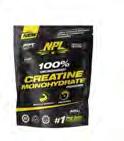
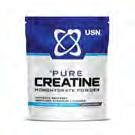

Whichever protocol you choose, it is ideal to split your intake into multiple daily doses and mix your creatine monohydrate with your favourite proteincarbohydrate drink or grape juice.

However, research8 confirms that either option will boost your resting levels by 17-20% .
Following this dosing protocol for optimal results:
1. Take one serving before training to stock up reserves.
2. Take another dose after your session to replenish depleted stores.
3. Take a single serving before breakfast on nontraining days.
While there are numerous creatine options available, each offering benefits from an absorption or tolerance perspective, creatine monohydrate remains one of the most efficacious, safest and cost-effective options.
According to the International Society of Sports Nutrition’s position stand10: “Creatine monohydrate is the most effective ergogenic nutritional supplement currently available to athletes in terms of increasing high-intensity exercise capacity...”
Accelerated recovery between sets and workouts
Increased strength
Higher work capacity
Greater strength endurance
Aids muscle cell hydration
Protects muscle against free radical damage11
Limits muscle loss during periods of immobility12
* To view references for this article, please visit www.livingfit.co.za/issue26/references or scan the QR code on page 7.
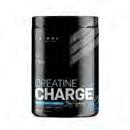




You can simplify your daily creatine intake with new innovations in creatine transport systems. There are numerous all-in-one products, which typically include a potent 5g dose of creatine monohydrate per serving with an added carbohydrate source like dextrose monohydrate and alphalipoic acid. These formulations mean you can simply mix with water and drink, no fruit juice required!
Creatine is a natural substance found in the body that plays vital roles in energy metabolism, helping to boost power and strength output and support repeated highintensity efforts.


Without sufficient glucose for fuel, the brain of marathon runners started to ‘eat’ its own fatty tissue from myelin for energy, according to a pilot study. Brain scans showed that 24-48 hours after the marathon, runners showed signs of losing a significant amount of myelin in brain regions associated with motor function, coordination and sensory and emotional integration. They returned to normal after about two months.
*Study published in Nature Metabolism.
Endurance athletes who strength train have better running economy, stronger joints, and fewer injuries.
“ENDURANCE IS PUSHING FORWARD WHEN COMFORT BEGS YOU TO QUIT.”
A new study examined the effect of long weekend exercise sessions on anxiety and found that “weekend warriors” had a 35% lower risk of anxiety than inactive people, with total weekly activity volume mattering more than workout frequency. The effects were also seen throughout the week.
*Study published in BMC Psychiatry.

People who push themselves when exercising tend to experience that time moves more slowly. Participants in a study who took part in a 4km cycling trial on exercise bikes overestimated how long they had been pedalling for by about 10%, making it feel as if they have been exercising for longer than they have.
*Findings published in Brain and Behaviour.
ASK THE PROS Exercise and Immunity...106 in this section
COACH’S CORNER Marathon Training...110 WORKOUT Pre-run Activation...120 RUNNERS 5 Tips for Race Day ...116
Could your fitness routine be making you sick instead of strong?
Gavin via social media

PHYSICAL ACTIVITY IS ONE OF THE BEST WAYS TO SUPPORT OUR IMMUNE SYSTEMS, BUT IT’S OFTEN A FINE BALANCING ACT WHEN YOU’RE ENGAGING IN HIGHVOLUME OR INTENSE TRAINING.
Moderate intensity exercise seems to be the sweet spot when it comes to improving immune function, offering potential to reduce the risk and severity of respiratory viral infections1
The right exercise type and intensity can also cause changes in immune cells, like antibodies and white blood cells.
While the exact mechanisms are still being researched, these changes may enhance the ability of immune cells to detect and combat illness.
DID YOU KNOW Research shows that short bouts of moderateintensity exercise can increase the levels of natural killer (NK) cells, which are crucial for destroying infected cells.
For example, research2 shows that even short bouts of moderate-intensity exercise can increase the levels of natural killer (NK) cells, which are crucial for destroying infected cells.
The study compared the effects of 15 or 30 minutes of moderate-intensity exercise on the mobilisation of white blood cells, including lymphocytes, monocytes and granulocytes. The team found that just 15 minutes of exercise at a moderate intensity effectively mobilised the white blood cells into circulation.
This mobilisation is only the first step, as exercise also increases heart rate and dilates blood vessels, which helps circulate the immune cells around your body more effectively. With these cells patrolling your body, they can more effectively detect and start fighting pathogens earlier.

Exercise supports deeper, more restorative sleep, which is critical for immune memory and recovery.
GET MOVING...
ACTIVITIES LIKE YOGA, TAI CHI AND PILATES CAN HELP REDUCE STRESS, which is a significant suppressor of the immune system.

Regular exercise can help reduce chronic low-grade inflammation, which is linked to various diseases and can impair immune function. Specifically, exercise promotes the release of anti-inflammatory cytokines (proteins) that can help regulate the immune response3
Exercise also activates the innate immune system – the body’s natural, non-specific defence system – to express cytokine production4, which modulates inflammation and the immune response.
Exercise can also have a less direct impact on immunity through its ability to reduce chronic stress, which is known to suppress the immune system. Certain exercises have been shown to lower the levels of stress hormones like cortisol, which may help protect against illness5
The key to unlocking the immune-boosting benefits of exercise is performing at least 150 minutes of moderate-intensity activities per week3
Activities like brisk walking, jogging, cycling, swimming and dancing improve circulation and have been consistently linked to better immune function.
While often focused on muscle building, strength training also contributes to overall health and can indirectly support immunity by reducing inflammation and improving metabolic health.
Activities like yoga, Tai Chi and Pilates can help reduce stress, which is a significant suppressor of the immune system.
While intense exercise has various health benefits, prolonged sessions of high-intensity exercise lasting more than 1.5 hours can temporarily suppress the immune system, leading to a phenomenon called post-exercise immunosuppression (PEIS)6.
PEIS is a physiological response to large training loads or strenuous exercise, which generally happens due to a rise in stress hormones such as adrenaline and cortisol.
As such, if you are looking to boost your immunity this winter, it is recommended that you limit your hard training sessions and engage in more moderate-intensity exercise that can support your immune system, rather than overload it.
*To view references for this article, please visit www.livingfit.co.za/issue26/references or scan the QR code on page 7.
YOUR FITNESS

Chronic fatigue often results from prolonged intense or high-volume training without proper rest or structured periodisation. It can also arise from sudden increases in training load or following repetitive, unvaried routines. Other contributing factors include emotional or physiological stress, poor nutrition — especially low intakes of protein, calories or essential nutrients — and restrictive diets that cut out key food groups like carbs or fats.
How much training a person can handle before chronic fatigue sets in depends on many factors, including recovery, lifestyle stress and individual physiology. Without proper recovery, the body — especially the muscular, nervous, endocrine and immune systems — gradually breaks down. Pushing through this fatigue often leads to overtraining syndrome. But since genetics, training history and lifestyle vary, so do recovery needs.

Overtraining is generally accompanied by frequent illness, especially upper respiratory tract infections (URTI) due to an overstressed immune system.
2. Reduced performance and an inability to progress
Anyone who is overtrained will generally find it difficult to perform due to a lack of power, endurance, strength and/ or speed. This spate of poor racing or workout performances could also result from the mental fatigue that accompanies overtraining. In fact, if left unchecked, your performances will eventually start to decline over time.
The length of time it takes you to recover between exercise sessions or races increases when you’re overtrained. Athletes who are overtrained also experience persistently high levels of fatigue and other symptoms like prolonged muscle soreness.
A sure-fire way to catch early signs of chronic fatigue, which is a precursor to overtraining, is to regularly measure your resting heart rate (RHR) as soon as you wake up, before you get out of bed. Recording this measurement will give you an indication of how well you’ve recovered. An increased RHR generally indicates early-stage overtraining, or the start of an illness.

Other heart rate-related factors to watch out for include your recovery heart rate – the length of time it takes your heart rate to drop once an exercise session has ended. If your heart rate doesn’t drop at least 12 beats in the first minute after exercise, or if your heart rate exceeds 120bpm after five minutes or 100bpm after 10 minutes, then you may be overtrained.
You may also experience reduced heart rate variability during training and a decrease in maximal heart rate. This means there’s little difference in your minimum and maximum heart rate during the session in response to changes in your pace or intensity, which results in a flattish HR graph with few peaks and troughs. In severe cases, heart palpitations can also occur. Low blood pressure, when considered in the context of these other symptoms, is another related cardiovascular indicator.
When you’re overtrained, your body generally works overtime to repair the damage you’ve accumulated over time. To access the energy needed to fuel this process, in addition to your ongoing high training volume, your body will break down both fat and muscle as circulating levels of the stress hormone cortisol increase. Overtrained athletes also often experience a loss of appetite, which reduces their calorie intake and creates an even bigger calorie deficit. This can lead to severe weight loss over a relatively short period of time.
When you are overtrained you may also experience changes in your mood, along with apathy, a loss of motivation, irritability, depression, restlessness and a loss of libido. Your sleeping patterns also change, often resulting in fitful sleep or even insomnia.
Chronic fatigue may require several days of rest or reduced activity to overcome, but recovery from overtraining syndrome may require weeks, months or even years of rest and treatment to cure. So, if you don’t want to miss that big race, lose all the gains you’ve made or take yourself completely out of action, then make sure you balance your training loads with adequate rest. LF

The challenge for many lies in transitioning from the half marathon to the full-distance event. However, with the right tweaks to your training plan, most runners can successfully double up and make the leap from 21.1km to the 42.2km marathon.
Read

Training for a marathon requires a solid foundation, which is built on base miles. This training phase lays the groundwork for the more intense, marathonspecific training that follows.
Lower-intensity base miles help develop your aerobic system, which improves your body’s ability to use oxygen efficiently – the primary energy source for long-distance running.
Your focus during base training is to gradually increase your volume, not your speed.
Most of your runs should be at an easy, conversational pace. Aim to gradually increase your mileage every week by roughly 10%.
The most important session in this training block is a weekly long run, which should gradually get longer to build your
CONQUERING THE ICONIC MARATHON DISTANCE IS THE ULTIMATE TEST OF ENDURANCE FOR ANY PASSIONATE RUNNER.
endurance.
Base training is not just about time out on the road, though. It is important to also develop the strength, mobility, coordination and skill required to run injuryfree over longer distances.
Invest time and effort into learning how to run and incorporate drills into your routine to perfect the art of running. There are numerous tutorials online or speak to an experienced and qualified coach or biokineticist to have your form assessed.
The duration of your base training phase will vary based on your experience level and current fitness. Generally, it should last for 4 to 12 weeks.
Beginners may need a longer base training phase while experienced runners who have multiple half marathon training blocks under their belt would need a shorter build.

With the base training phase complete, it is time to start adding intensity and structure to your plan.
A 16 to 20-week marathon training block is where the real marathonspecific work happens.
It’s a structured period designed to push your fitness to its peak, preparing you for the unique demands of 42.2km.
Similar principles apply during this training phase:
Gradually increase your weekly mileage by roughly 10%.
A common structure is three weeks of increasing volume followed by one week of recovery.
ADD INTENSITY: This is when you start including 2-3 speed sessions a week.
GO LONG: Keep building on your long runs, until you get to about 85% of the race distance. That’s roughly 36km for the marathon. Aim to complete this long run 4 weeks before race day.
The structured training included in a marathon block varies and should align with the course and route
For example, a flat race profile would require little if any hill work and lots of speed and speed endurance training on flat routes.
Hilly races would require more hill-specific drills, like hill repeats and long runs that incorporate similar vertical ascent (VA).
In general, you should structure your marathon phase training with a mixture of the following workouts in your plan 2-3 times a week:
TEMPO RUNS: Sustained efforts at a comfortably hard pace, designed to improve your lactate threshold. The pace is usually around marathon and half marathon pace.
INTERVALS: Short periods of above-threshold efforts followed by active recovery (walking or jogging) or rest periods. They improve your speed and running economy.
FARTLEKS: A Swedish word meaning “speed play”. These versatile workouts combine steady running with variable bursts of faster-paced running.
PROGRESSION:
Start at an easy pace and increase your speed for every subsequent kilometre, working down to 1km efforts that are faster than marathon pace over the closing kilometres.
MARATHON EFFORTS:
These runs help you get accustomed to your target marathon pace by teaching your body to maintain that pace for extended periods.

TEMPO RUNS
A sustained 30 to 60-minute effort at your target race pace or slightly faster.
Run hard intervals (200, 400, 800, 1000, 1600m) at 3-5k pace and recover for 200m or rest for 45-90 seconds. Repeat to get a total workout distance of between 6-12km.
FARTLEKS
Week 1: 1 min on (faster than race pace), 1 min steady for 30-60 minutes
Week 2: 2 min on (faster than race pace), 1 min steady for 30-60 minutes
Week 3: 3 min on (faster than race pace), 1 min steady for 40-60 minutes
PROGRESSION
KM 1: Easy pace
KM 2: +10% faster
KM 3: +10% faster
3km to go: Marathon pace
Penultimate KM: Half marathon pace
FINAL KM: 5-10k pace
MARATHON EFFORTS
Beginner: Long run with 3 x 10-15 minutes at marathon pace with a 5-minute float recovery. Intermediate: Long run with 4 x 5km at marathon pace with a 1km float recovery. Advanced: Long run with 4 x 10km with 2 min rest between.
Continue with your strength training, but reduce the volume and frequency to 1-2 times a week as your long runs increase. This will help to maintain strength and prevent injury.
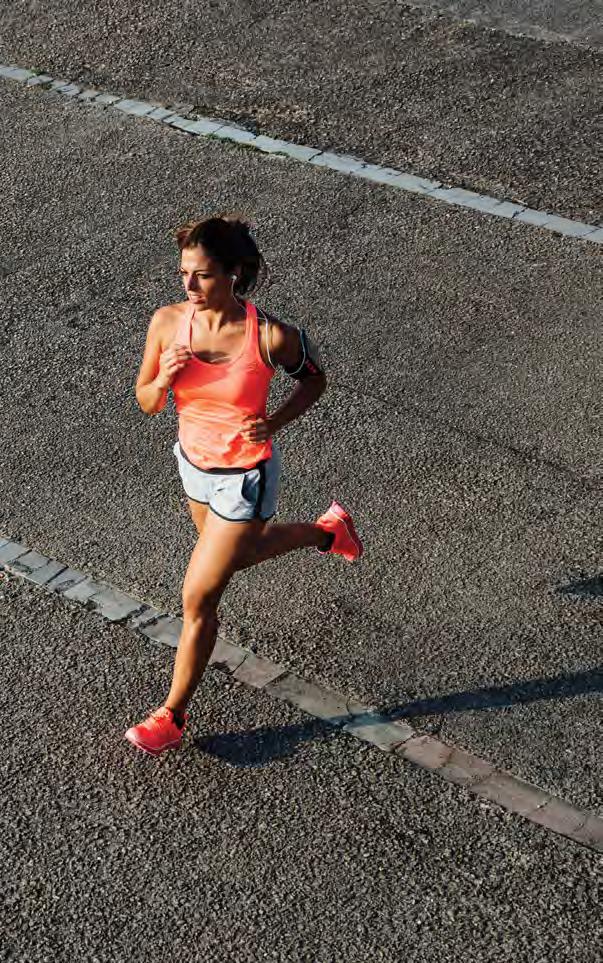

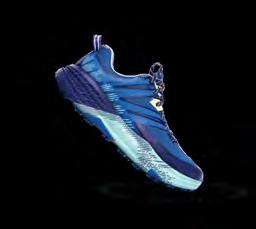
Every comprehensive plan needs a mix of speeds and intensities over different distances across various workouts to complement the longer, slower runs (typically a shorter mid-week longish run and a traditional long run over the weekend) to build that aerobic base.
A balanced weekly training structure should look something like this:
MONDAY: Easy or rest
TUESDAY: Speed/intensity session
WEDNESDAY: Mid-week longer run
THURSDAY: Speed/ intensity session
FRIDAY: Easy or rest
SATURDAY: Easy (beginner) or speed/intensity session
SUNDAY: Long run
An ideal approach would include a track interval every Tuesday (#TrackTuesday) and alternate between fartleks and tempo efforts on a Thursday.

More mileage means more stress on the body, which is why focused and intentional recovery becomes even more important during marathon blocks.
Your aim when training for a marathon is to maximise your recovery between sessions to ensure you are not breaking down your body but rather building it up.
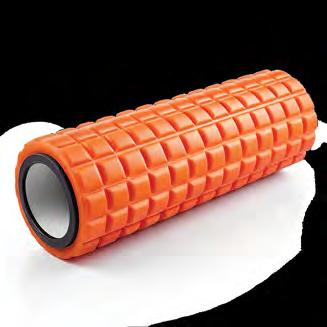
Nutrition is key to both performance and recovery. Prioritise your post-run meal, making sure you get in some protein and carbs.
While whole foods should be your primary focus, supplements can help meet the increased training demands.
Adjust your carbohydrate intake based on the intensity and duration of your training, eating some easily digestible carbs after training along with some protein from a meal or a carb-protein recovery shake.
Incorporate these recovery tools and techniques into your routine:
Active Recovery: Don’t just sit on the couch. Incorporate hot-cold therapy, foam rolling, mobility drills, stretching and massage.
Sleep: Aim for 7-9 hours of quality sleep each night. It’s when your muscles repair and adapt.
Manage Inflammation: High-volume training can lead to inflammation. Ensure adequate vitamin D levels and prioritise sleep to support your immune system.
Aim for 1.6-2.2g protein per kg of body weight spread throughout the day to support muscle repair and limit muscle breakdown.



Salmon, Sweet Potato & Steamed
Bowl: Combines anti-inflammatory nutrients with high-quality protein and slow-digesting carbs for a full recovery boost.
Biogen Recovergen: Formulated to provide the scientifically recommended 4:1 ratio of carbohydrate to protein, through fastacting sources such as maltodextrin and hydrolysed whey protein.
The final 2-3 weeks of the training block involve tapering, a gradual reduction in mileage to allow your body to recover and prepare for race day.
A taper gives your body the time it needs to adapt to the training and ‘peak’ before race day. It involves manipulating both the volume and the intensity of the training during the taper period to reduce fatigue without losing training-induced adaptations.
The taper isn’t about stopping completely, though. It’s a strategic reduction in training volume that
Marathon taper guidelines:
WEEK 1:
Reduce training volume by 40-50% from your peak week
Monday: Easy run
Tuesday: 10 x 400m at slightly faster than race pace
Wednesday: Longer easy run
Thursday: Fartleks with some race pace bursts
Friday: Rest
Saturday: Run 18km
Sunday: Recovery run
allows your body to recover and rebuild, leaving you feeling refreshed and ready to unleash your full potential.
However, it is important to maintain the intensity in your training, and possibly increase it in the run-up to the race. Prioritise quality workouts during the taper by including a few shorter high-intensity sessions to sharpen your neuromuscular system.
Work at a race-pace intensity or slightly higher during these sessions, incorporating a few intervals or bursts. The trick is to leave this short but intense training session wanting more.


WEEK 2:
Reduce training volume by 60-70% from your peak week
Monday: Easy run
Tuesday: 10 x 200m at slightly faster than race pace

Wednesday: Easy run
Thursday: Rest
Friday: Easy run with strides
Saturday: 15-20 minutes with a few strides
Sunday: Race
Lace up, level up - download now and run smarter!

Expert insights, step-bystep exercises and training protocols to boost your speed, endurance and resilience on the track or road.

A proper warm-up is essential to unlocking your full potential, whether you’re hitting the track, tackling intervals or racing toward your next PB.




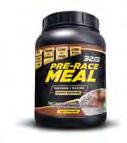

Race day is finally here — the months of training, the early mornings and the countless kilometres have all led to this moment. But with the buzz of the crowd and a surge of adrenaline, it’s easy to let excitement override strategy. To help you stay focused, avoid common mistakes and cross the finish line strong, we’ve rounded up the most essential, tried-and-true tips for a successful race day.



Don’t try new, untested gear on the day, especially new running shoes.
Every endurance coach will tell their clients: “Nothing new on race day.”
That means sticking to the nutrition, hydration and fuelling strategies you’ve tested and used during your training, including the breakfast you eat in the morning.
And don’t try new, untested gear on the day, especially new running shoes. Untested gear can cause chaffing and blisters, which are not only uncomfortable but can also detract from your performance if they become too painful.
Make sure you’ve done a few training runs in your vest and shorts before your race, and that your shoes are adequately worn in and are correct for your biomechanics. The wrong shoes can lead to injury.
The general mantra for endurance athletes is eat and drink early and often. Consume controlled amounts at planned intervals. Don’t overdo it as this can lead to stomach and digestive issues while out on the course, and don’t deviate from the plan that you perfected during your training. Also, make sure you eat a tested and trusted pre-run breakfast before your race, despite the early start. You need to replenish your energy stores after the night-time fast. And you don’t want to start the race on an empty stomach and in a depleted state.
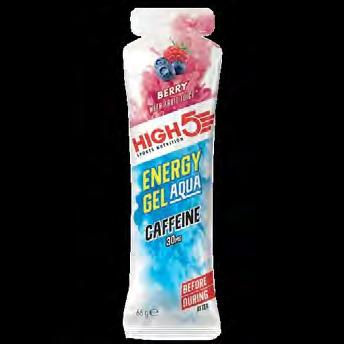

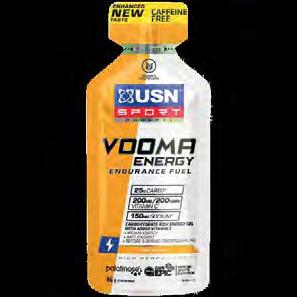

You trained according to a set plan to achieve a specific goal time. That means your training conditioned your body and mind to sustain a certain level of effort and intensity over the race distance.
However, runners often get caught up in the excitement of the mass start and go out too fast with the bunch. This is a recipe for disaster because a harder effort in the first half of a race will sap your energy reserves for the remaining kilometres.



So stick to your pacing plan from the first kilometre to have the best chance of achieving your goal time. Only if you’re feeling good in the closing stages of the race should you up the pace.
General recommendations for carbohydrate ingestion during events include:
60-150 minutes: 30–60g/hour
150 minutes+: 60–90g/hour (based on tolerance) with feeds every 15-20 minutes

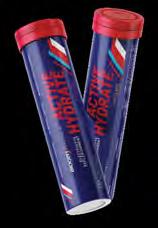
A common mistake made when training and racing in winter is not drinking enough fluid. That’s why dehydration is often a more common issue in winter than it is in summer.
Researchers at the University of New Hampshire confirmed this in a study that found that your chance of dehydration actually increases during the colder months because people don’t feel as thirsty when the temperature drops and, as such, forget to drink enough water.
So make sure you start the race with optimal hydration levels by drinking an electrolyte tab in some water the day before and the morning of the race. And make sure you take small sips periodically along the route, even if you don’t feel thirsty.
With so many people converging on a central point, there is always traffic congestion. Don’t stress yourself out or miss your start time by arriving late.
So get your gear and race day nutritional needs ready the day before to ensure a hassle-free morning. And leave a little earlier to enjoy a stress-free trip to the start, with time left to warm up and get to the start line with time to spare.
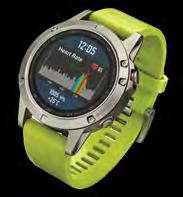

DON’T STRESS YOURSELF OUT OR MISS YOUR START TIME BY ARRIVING LATE.
One of the biggest mistakes runners make on race day is abandoning their pacing plan and running purely on feel. While the surge of adrenaline at the start can make you feel invincible, it often leads to going out too fast and burning out early. To avoid this, stick to the pace you’ve trained for and practiced, using tools like a GPS watch or pace band to help you stay on track and conserve energy for the final stretch.
A STRONG RUNNER IS A FAST AND EFFICIENT RUNNER. Don’t forget to include exercises – at least twice a week – that target your glutes, hips, core and legs.
Ideal options include lunges, step-ups, hamstring curls, banded squats, monster walks, hip thrusts, planks, sit-ups, dead bugs and ball rollouts.

These exercises improve stability while running, which reduces injury risk and helps you generate the power needed to run faster for longer.
Flip the switch on your running performance by turning on muscles with the right activation drills.

Getting your body ready to run needs more than a few quick stretches. Whether you’re a seasoned marathoner or a casual jogger, what you need is a set of movements and exercises that mobilise joints for increased range of motion and prime your muscles to fire properly for better movement efficiency.
Activation drills are targeted dynamic movements designed to “wake up” specific muscle groups and get them working together as they should before you start your workout or race. Unlike static stretching, which focuses on lengthening muscles, activation drills prepare your body to move by stimulating the neuromuscular system, increasing blood flow and promoting joint mobility. Taking just 5–10 minutes before your run to properly activate your muscles can supercharge your running performance and reduce your injury risk. For a quick and effective routine that targets all the muscles and joints you need to be a better runner, use these pre-workout activation drills as part of your warm-up.

This dynamic stretch gently activates the hip flexors, glutes and hamstrings, while also improving balance and coordination. It’s a fantastic way to prepare your lower body for the demands of running.
How to do it: Stand tall with feet
hip-width apart. Step forward with your right foot, then lift your left knee to your chest, gently hugging it with both hands for 1–2 seconds. Release, step forward onto your left foot, and repeat with the right knee. Continue walking forward, alternating knee hugs.
FORM TIP: Engage your core to help maintain balance as you lift each knee.

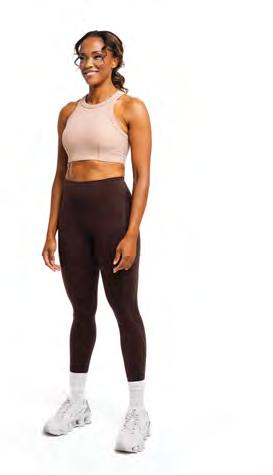


This dynamic drill is fantastic for waking up your hamstrings, glutes, hip flexors and core – all crucial for efficient and powerful running.
How to do it: Stand with feet
hip-width apart, core engaged. Step forward with your right leg, keeping it straight, and reach your left arm toward your foot. As you plant your foot, swing your left leg forward and reach your right arm to it. Continue walking forward, alternating straight-leg kicks with opposite arm reaches.
Form tip: Maintain an upright torso and avoid excessive bending at the waist.
Known as CARs (controlled articular rotations), this drill mobilises and increases controlled range of motion in the hip joint, preparing the surrounding muscles for the demands of running.
How to do it: Stand with feet hip-width apart and core engaged. Lift your right knee to 90 degrees, then slowly rotate it in a wide circle — forward, across, out to the side, back, and down. Perform 5–8 slow, controlled rotations, then switch legs.
FORM TIP: Focus on a controlled movement, rather than stretching specific muscles.
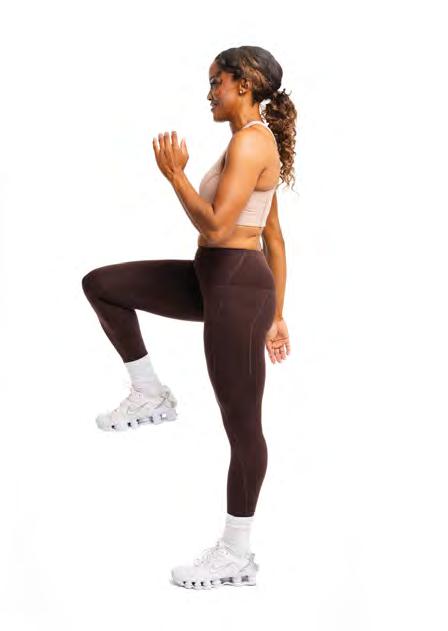

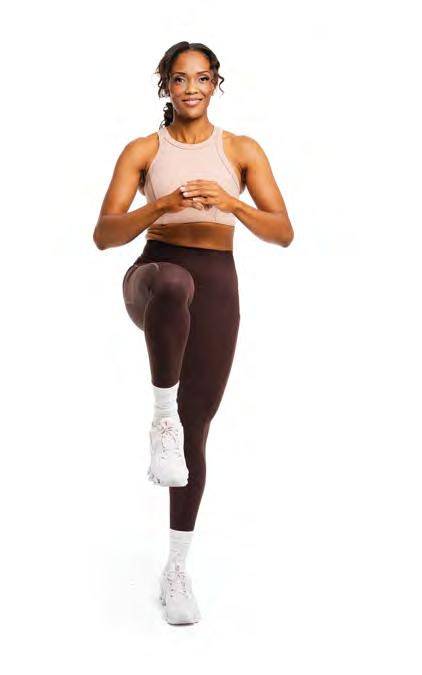

Get your posterior chain firing and sharpen your balance with single-leg Romanian deadlifts (RDLs). Gently activate your glutes, hamstrings and lower back unilaterally to improve balance and stability, and enhance proprioception – crucial elements for efficient and injury-resistant running.
How to do it: Stand with feet hip-width apart, core engaged. Shift your weight to your left leg and extend your right leg back. Hinge at the hips, lowering your torso while lifting your right leg behind you until parallel to the ground. Keep your back straight. Engage your glute and hamstring to stand upright. Do 5–8 slow, controlled reps per leg.
FORM TIP: Focus on feeling a gentle stretch in the hamstring of your standing leg and the engagement of your left glute to control the movement.
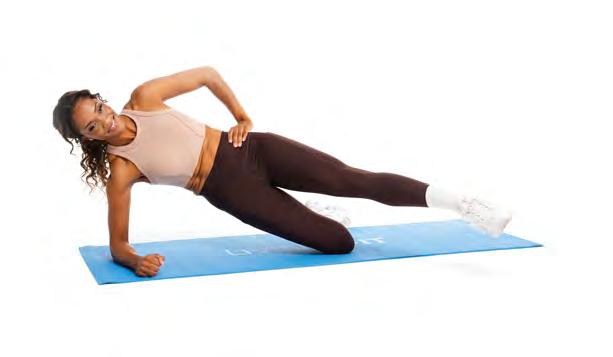
Get those lateral stabiliser muscles (obliques, quadratus lumborum) firing and your hips ready for some dynamic movement with some gentle mobilisation of the hip joint.
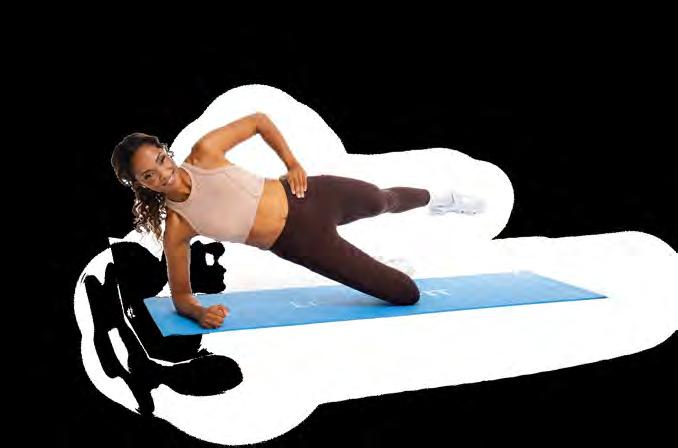
Dynamically activate the major muscle groups used in running (quadriceps, hamstrings, glutes, and calves), improve balance and coordination and increase hip flexor mobility in a functional, weightbearing manner.
How to do it: Start in a modified side plank: right forearm and knee on the ground, left leg extended. Engage your core and lift your hips into a straight line from head to knee. Swing your left leg forward and backward with control for 8–12 reps, then switch sides.
FORM TIP: Focus on initiating the movement from your hip joint, emphasising smooth, controlled swings in both directions and avoiding any jerky motions.
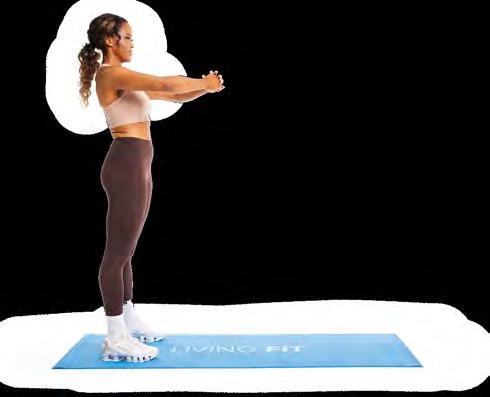

How to do it: Stand with feet hipwidth apart, hands to your front, core engaged. Step forward with your right leg, lowering into a lunge with your front thigh parallel to the ground and back knee just above the floor. Twist your upper body into the same direction as the leading lunge leg. Return to front facing, then push off your right foot and step forward into the next lunge with your left leg. Continue alternating for 5–10 reps per leg.
FORM TIP: Ensure your torso remains upright and your core stays engaged to maintain balance. Avoid leaning excessively forward or backward.



Improve ankle dorsiflexion (the ability to bring your toes toward your shin) to improve your running mechanics, especially during the stance phase. This drill uses the deep squat position to gently load the ankle joint and promote increased range of motion.
How to do it: Stand with your legs a little wider than your shoulders. Drop into a deep squat. Rest your elbows on the inside of your thighs. Rock back and forth and side to side to mobilise your ankles and settle into the stretch.
FORM TIP: Go as low as you comfortably can while keeping your heels on the ground.
Activation drills may seem like a small, insignificant addition to your routine, but they offer big benefits, helping your body transition from rest to movement to elevate your performance and reducing the likelihood of injury.
Get your glutes and hip stabilisers firing by activating the glute medius and minimus. This drill helps improve lateral hip strength, which is crucial for maintaining proper running form and preventing injuries.
How to do it: Place a resistance band around your ankles and stand with knees slightly bent. Shift your weight to your left leg and move your right foot in a controlled half-moon arc — side to front and back. Do 8–12 reps, then switch legs.
FORM TIP: Maintain tension on the band throughout the movement and consciously engage the muscles on the outside of your right hip.





Prep those feet and ankles for a smooth run by gently activating the muscles in the feet, ankles and lower legs, improve ankle mobility and stability, and enhance proprioception.
How to do it: Stand upright with your feet about hip-width apart and your body aligned from head to heels. Gently lift both of your heels off the ground, coming up onto the balls of your feet. Hold it for just a second at the top, feeling the stretch in the calf muscles. Slowly lower your heels back down to the floor.
FORM TIP: Maintain an upright posture with your head up, shoulders relaxed and core engaged. Avoid leaning forward or backward excessively.
Get your leg muscles firing and ready to propel you forward with these knee drives. This drill activates the hip flexors, glutes and core muscles, which are essential for your running gait, and improves coordination between the hip and core.
How to do it: Stand tall with a resistance band looped around your feet, with your feet about hip-width apart. Lift one knee toward your chest in a marching motion. Only go as high as feels comfortable. Lower your foot back down with control, and then repeat on the other side.
FORM TIP: Actively engage your core muscles to keep your torso stable and prevent excessive leaning or twisting.



Energy gels have transformed the way athletes fuel for endurance sports, ushering in a new era of performance nutrition. The latest innovations are pushing the limits of what’s possible, allowing athletes to tolerate higher carbohydrate loads than ever before during intense, sustained race efforts.
The first energy gels hit the market in the 1980s as endurance sports became more mainstream. New Zealander Brian Frank reportedly developed the first commercial energy gel under the Leppin Squeezy brand in an attempt to create a concentrated carbohydrate source that was easier to consume and digest than whole foods.
Today, an explosion of brands now develop a range of gels boasting different formulations and an ever-expanding range of flavour and texture options.
Energy gels provide athletes with a convenient and fast-absorbing source of carbohydrates to maintain energy levels during prolonged exercise.
These compact, portable sachets (you can easily fit multiple gels into pockets or pouches) of concentrated carbohydrate solutions help prevent glycogen depletion, which

can lead to fatigue and decreased performance.
Energy gels either contain a mix of carbohydrates or are exclusively glucosebased. More advanced formulations can also include a mix of electrolytes, caffeine and amino acids for enhanced performance and recovery.
Performance nutritionist Dr Craig Uria, who is the Director at Spine and Sport Centre, a multidisciplinary practice focusing on health, performance and injury management, explains that endurance athletes should aim to ingest around 60-90+g of carbs per hour, based on factors such as effort, digestibility, palatability and tolerance.

possible to train your tolerance for higher intakes, which is highly beneficial for more serious athletes.”
Athletes who aren’t racing flat out typically tolerate 60-70g well while those working near their aerobic threshold should aim for 90g or more per hour.
“You need to establish your plan based on your goals. It is also
“Some elite athletes manage up to 120g/hour thanks to innovations in supplement technology that provides up to 40g per serving from gels and drinks.”
A significant development in this regard is the 1:0.8 glucose-to-fructose ratio used in a growing number of energy supplements.
This ratio is gaining popularity because it allows for higher carbohydrate intakes with less risk of gastrointestinal (GI) discomfort. The ability to tolerate carb intakes of 90g per hour or more improves endurance performance.
Studies1 also suggest that a 1:0.8 glucose-to-fructose ratio can support higher carbohydrate oxidation rates, which means athletes can convert more of what they consume into usable energy.


The 1:0.8 ratio works because glucose and fructose use separate transport mechanisms in the gut.
Glucose is transported via the sodium-glucose-linked transporter 1 (SGLT1) pathway.
Fructose is absorbed through the GLUT5 transmembrane protein transporter.
This means that while the human body can absorb and oxidise glucose at a rate of approximately 60g/hour2, when glucose is combined with fructose, total carbohydrate absorption can increase to 90-120 g/hour.

Athletes can tolerate intakes of up to 90g/hour from products with a 2:1 glucoseto-fructose ratio. However, fructose is very sweet, which makes larger doses less tolerable from a taste and stickiness perspective3
It is only since products were developed with the 1:0.8 glucose-to-fructose ratio that more athletes have been able to tolerate up to 120g of carbs per hour

A 2011 study1 confirmed that ingesting 110g of carbohydrates per hour in the form of glucose and fructose in a 1:0.8 ratio led to a higher use in the muscle than the same intake in a 2:1 ratio. Moreover, the 1:0.8 ratio group performed better than the 2:1 group.

While these products boost absorption, your ability to tolerate higher carb intakes during races is highly individualised. However, it is something you can train and develop, says Dr Uria.
“It is possible to train your tolerance for higher intakes, which is highly beneficial for more serious athletes.”
In this regard, Dr Uria recommends simulating race conditions during training as much as possible to confirm that you can physically consume all the food, drinks and gels at those intensities and perform tasks like accessing and consuming gels.
Your performance nutrition plan should also have structure, with timed feeds to ensure you eat and drink early and often according to your planned and practised schedule.
The plan must ensure you get the required carbs and calories needed every hour to sustain your efforts.
“Some people find it easier to eat more solids at the beginning, with liquid and gel feeds better tolerated later in the race or at higher intensities as the gut gets less blood flow,” continues Dr Uria.
“Technically, there is little difference in the rates at which we oxidise solid and liquid carb sources based on research. It’s more about personal preference and digestive comfort.”
Dr Uria says you should consider other factors like flavour and texture fatigue.
“We have a wider range of options than ever before, which makes it easier to mix and match products and brands for the best experience and ideal outcome.”

